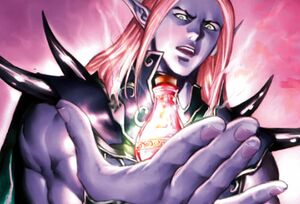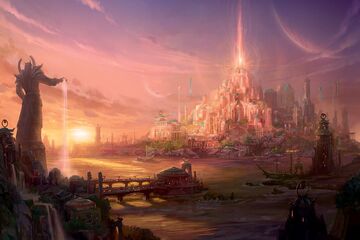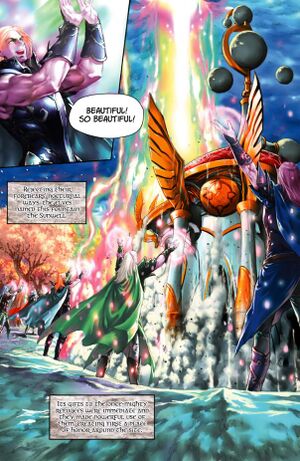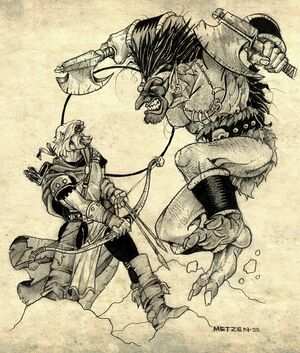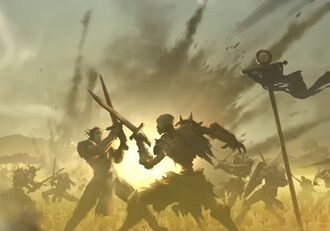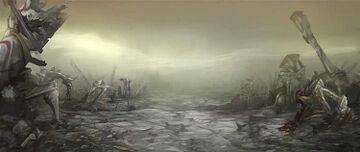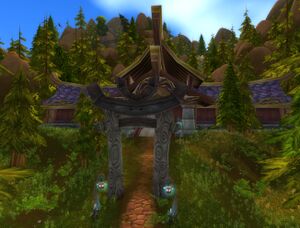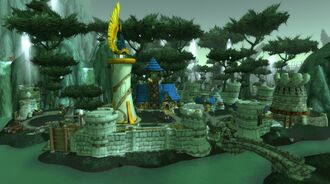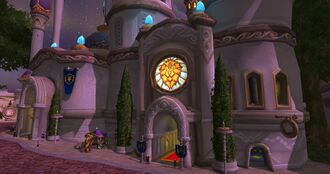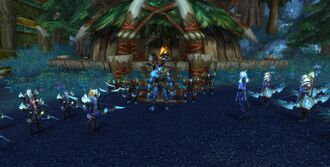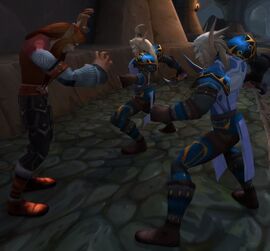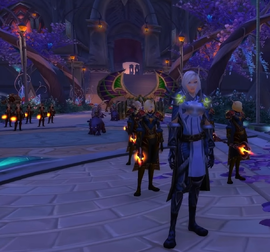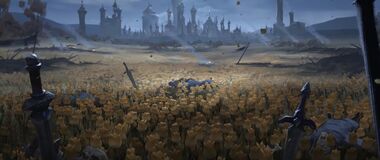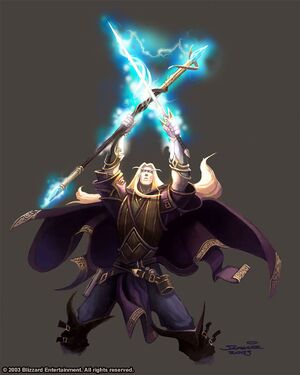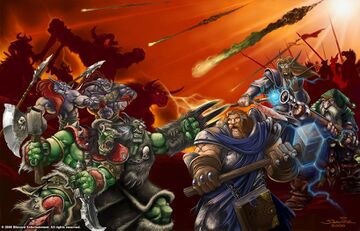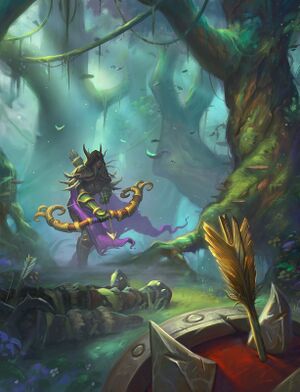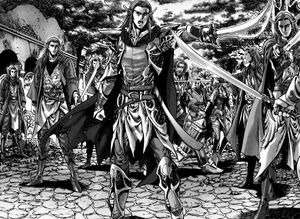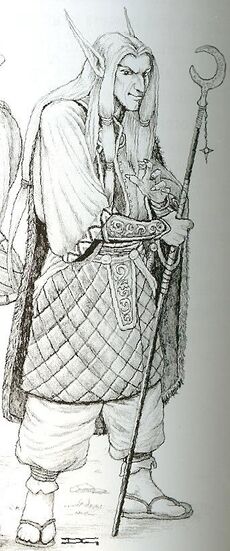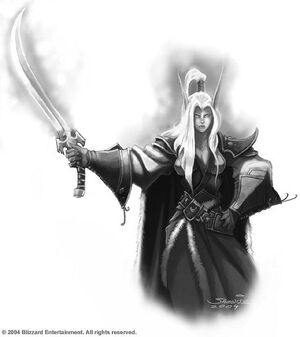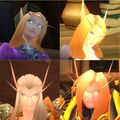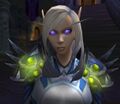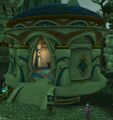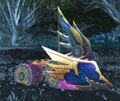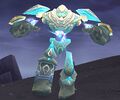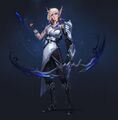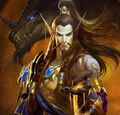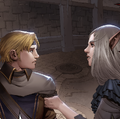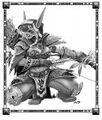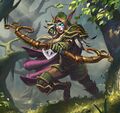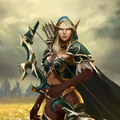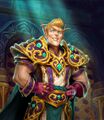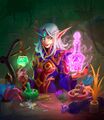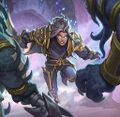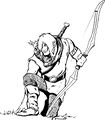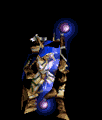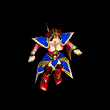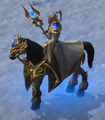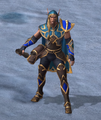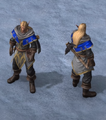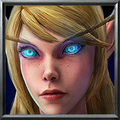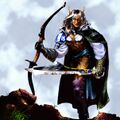High elf
- This article is about high elves in the lore. For the playable races with the same appearance, see Blood elf (playable) and Void elf (playable).
| High elves | |
|---|---|
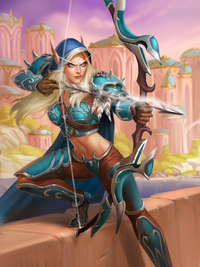 | |
| Faction/Affiliation |
Alliance, Highvale, 7th Legion, Sons of Lothar, Magocracy of Dalaran, Silver Covenant, Kirin Tor, Tirisgarde, Argent Crusade, Silver Hand, Unseen Path, Cult of the Damned, Independent Formerly: Nation of Theramore, Kingdom of Quel'Thalas, Alliance of Lordaeron |
| Character classes | Arcanist, Archer, Archmage, Assassin, Conjurer, Death knight, Dragonhawk rider, Emissary, Hawkrider, Hunter, Mage, Necromancer, Paladin, Priest, Ranger, Scholar, Scout, Sorcerer, Rogue, Warlock, Warmage, Warrior |
| Racial capital | None |
| Formerly | Silvermoon City |
| Racial leader(s) |
|
| Formerly |
|
| Racial mount |
|
| Homeworld | Azeroth |
| Area(s) | Azeroth, Outland |
| Language(s) | Thalassian, Darnassian, Common |
The high elves, or quel'dorei ("children of noble birth" in Darnassian and Thalassian[8]), are a race descended from the night elf Highborne who settled in the Eastern Kingdoms millennia after the Great Sundering, founding the kingdom of Quel'Thalas under the rule of the Sunstrider dynasty. For nearly 7,000 years, the high elven society centered on the sacred Sunwell, a magical fount created from a vial of pure arcane energy from the first Well of Eternity. Nourished and strengthened by the Sunwell's potent energies, the high elves prospered within the verdant forests north of Lordaeron.
Throughout history, the high elves as a whole were relatively secluded from the younger races, though both the Troll Wars and the Second War saw relations established with humanity, forging alliances with the Empire of Arathor against the Amani Empire and the Alliance of Lordaeron against the Old Horde respectively. The elven kingdom's reluctant allegiance to the latter proved short-lived, as High King Anasterian Sunstrider quickly grew apathetic to the plight of his allies, and officially seceded his nation a few years after the destruction of the Dark Portal.[2][9] Nonetheless, some high elves chose to remain true to their human and dwarven allies despite the edicts from their reclusive masters in Quel'Thalas,[10] and to this day still support the modern Alliance.[9]
During the course of the Third War, the high elven kingdom was brought to the brink of annihilation when the death knight Arthas Menethil launched the Scourge invasion of Quel'Thalas. Approximately 90%[11] of their population was slaughtered by the undead.[12] Rallied by Ranger Lord Lor'themar Theron, second-in-command of the fallen Sylvanas Windrunner, 90% of the high elven survivors rejoined with Prince Kael'thas Sunstrider and renamed themselves "blood elves" or "sin'dorei" (children of the blood in Thalassian) in remembrance of their fallen brethren, no longer considering themselves high elves.[13] The blood elves then sought to unite and restore their people to the glory they enjoyed at the height of high elf civilization,[14] and have since retaken much of their land from the Scourge.[13]
However, a fraction of the high elves refused to rename themselves blood elves, and while they are physiologically the same race, the difference is only political.[15] Unwilling to lead a divided nation, Regent Lord Lor'themar exiled from Quel'Thalas those who refused to follow the ways of the blood elves,[16] while others chose to rejoin their former allies, arriving to a cold reception due to their previous secession.[2] Since high elves did not gather in any significant numbers and are a very small group of individuals, they are a rare sight across Azeroth, and are commonly mistaken for blood elves.[17][18]
As a people, the high elves are all but extinct: the remnants of the remnants of a fallen race.[19] They cannot even truly be said to have a culture, only a past filled with glory and regret.[2] Though they are scattered all over the world, without common opinions, goals, or any official leader,[2] Ranger General Vereesa Windrunner founded the Silver Covenant, a militant faction of high elves affiliated with the Alliance in Dalaran City. Following the Battle for Quel'Danas, Captain Auric Sunchaser of the Allerian Stronghold became the high elven representative at the restored Sunwell.
History
Exile of the Highborne
- Main article: Highborne
In the centuries following the War of the Ancients, the night elves adopted druidism and outlawed the practice of arcane magic, which became punishable by death. However, many Highborne who survived the Great Sundering grew restless, since they viewed magic as their birthright and suffered from magical withdrawal. At their head, Dath'Remar Sunstrider chafed at the restrictions that weighed on his kind, and eventually, he and his followers began to practice the arcane arts without fear or restraint, daring the other night elves to act. More than just an act of rebellion, they had always believed that night elves were destined for greatness, and wanted a new great elven empire to rise which to make happen would require arcane magic. Around 7,300 BDP, the Highborn spoke against Archdruid Malfurion Stormrage, thinking that the lowborne majority had no right or knowledge to dictate the use of magic.[20] They declared the druids cowards for refusing to wield the arcane, and while Malfurion warned the Highborne that any use of magic would be punished, Dath'Remar's followers unleashed a terrible magical storm upon Ashenvale in an attempt to protest against the night elves' law.[21]
Ultimately, the night elves could not bring themselves to put so many of their kin to death, so they decided to exile the reckless Highborne from their lands and barred them from setting foot on Mount Hyjal ever again, cutting them off from the Well of Eternity's energies. Most of the Highborne happily accepted their banishment, glad to be rid of their conservative cousins and free to practice the arcane with impunity. Thinking ahead, they also contrived to steal one of the magical vials containing pure energy from the first Well of Eternity that had been confiscated from Illidan Stormrage.[20] Under Dath'Remar's guidance, the Highborne built a fleet of mighty ships and set sail upon the seas. None knew what lay beyond the Maelstrom, but their determination was rewarded when they made landfall on a new continent some years later, which would one day become known as the Eastern Kingdoms.[22]
From that point, the Highborne traveled on foot for months, before finally settling in a place called Tirisfal by tribes of primitive humans that inhabited the area. In time, the Highborne detected potent ley energies in the land, and while it was no Well of Eternity, the lingering supernatural presence intrigued the experienced arcane practitioners. Some speculated that they could unlock its secrets and restore themselves to their former glory, and they were desperate to succeed quickly. After being exiled, they had become completely severed from the life-giving energy of the Well of Eternity, which meant that they were vulnerable to the elements and had not received immortality from Nozdormu and the World Tree. They gradually shrunk in height, their skin had become a peach hue similar to most dwarves and humans, and they began to feel the effects of aging and disease. The Highborne feared that the effects would only worsen over time.[23]
For a time, the elves dwelled in peace, yet, as they tapped into the area's latent magic, they found shades of dark energy that drove some of them to madness. As they determined whether they should force the human's settlements to relocate from the most potent ley lines, or just conquer the primitive beings, Dath'Remar refused to war against a people who posed no threat to his kind and theorized that they might be responsible of this situation. Ultimately, he chose to lead his people away from Tirisfal to avert violence, sparing them from further calamity. After they wandered the land for years,[24] they sought to make a new home in the north where their scouts had discovered a region rife with lush forests and powerful ley lines.[23]
Rise of Quel'Thalas
- Main article: Quel'Thalas (kingdom)
Around 6800 BDP, the Highborne's journey proved unexpectedly brutal when a ferocious blizzard stopped them for nearly a month, with no way to move forward or escape from the mountain passes. They quickly realized just how vulnerable they had become without the Well of Eternity, and for the first time in memory, they began to die of starvation. Only the compassion of some primitive humans living in the mountains kept the entire expedition from perishing in the winter's fury. Once the storm lifted, the Highborne forged ahead, shaken but determined to find a new home. As they drew closer to the northern lands, the ground beneath them crackled with potent lines of magic and hope warmed their weary hearts. But they soon discovered that another race also called this region home: the barbaric Amani trolls. Harboring a bitter hatred of elves from the days of Queen Azshara, the infuriated trolls sent out raiding parties immediately, and the Highborne soon learned to fear troll ambushes in the dense forests. Yet the elves stubbornly pressed forward, using their magical prowess to decimate any Amani who dared cross their path.
Despite the trolls' ferocity, the elves finally reached the nexus of ley lines they had been seeking, where powerful torrents of arcane energy converged. To sate their hunger for great magical power, Dath'Remar Sunstrider proclaimed that this was where they would begin their civilization anew, and before the eyes of his followers, he poured the vial into a small lake at the center of the nexus. A brilliant fount of energy tore through the skies of Azeroth, and the Highborne dubbed this glorious cradle of power the Sunwell, a name chosen in honor of Dath'Remar and his bold quest to reignite their culture. It became the source of their power as the Well of Eternity had been in Kalimdor, and although the Sunwell was much weaker, the elves were forewarned of the dangers.[2] Thereafter, the Highborne abandoned their traditional worship of Elune and the moon, instead taking their strength from the sun.[25][26] The amount of arcane power available to the elves increased by an astonishing degree, and many of them proclaimed that Dath'Remar had brought them salvation, crowning him the first king of Quel'Thalas. They called their new land Quel'Thalas or "High Home" in Thalassian, and declared that it would dwarf the night elves' civilization and stand as a monument for the ages.[27] In time, they would even be known by a new name: high elves, and from that point on, all had access to the Sunwell's powers from anywhere on Azeroth. Over time, the Sunwell's unique energies became part of them acutely and they came to regard its waters as holy.[2]
However, the high elves had built their new kingdom atop ancient Amani ruins, which were still considered hallowed ground by the forest trolls of Zul'Aman.[28] Outnumbering the elves by more than ten to one, the Amani struggled ferociously to drive the invaders from their sacred land. The quel'dorei drew on the full might of their newfound power, barely holding off the trolls' assaults. They could not understand how the trolls' weapon enchantments were more powerful than their own. Subsequently, they stole ancient knowledge from troll spellcasters, including the famous Zanza, and used stolen idols to craft their own versions of the troll enchantments.[29] High King Dath'Remar himself led almost every battle against the trolls, and bit by bit, the elves carved out the borders of their kingdom. Yet many quel'dorei grew wary of their rampant use of arcane magic, fearing that it could draw the Burning Legion to Azeroth once again. High King Dath'Remar ordered his most powerful arcanists to find a solution, and over several decades, they built a series of monolithic Runestones around Quel'Thalas' borders. This barrier was called Ban'dinoriel, or "the Gatekeeper" in the high elven tongue. It would prevent others from detecting the elves' usage of arcane magic, and it would also frighten away the superstitious Amani. The trolls eventually retreated back to Zul'Aman, where they decided it was safer to ambush elven convoys that strayed beyond the magic barrier rather than to launch a full-scale assault on Quel'Thalas. An elite group of high elf rangers soon arose to combat this threat.[30]
Inside the borders of Quel'Thalas, the kingdom became a shining monument to high elven prowess, and was crafted in the same style as the halls of Kalimdor. Although they did not worship it, a great respect was maintained for nature and the quel'dorei were careful to interweave their cities and architecture with their natural surroundings, creating a truly beautiful and tranquil land.[28] No longer fearful of using magic, the high elves created marvelous works and bathed their land in eternal springtime.[2] Never again would they experience another winter as brutal as the one they had suffered en route to this land. In time, the Convocation of Silvermoon was founded as the ruling power over Quel'Thalas, though the Sunstrider dynasty maintained a modicum of political power. Comprised of seven of the greatest high elf lords, the Convocation worked to secure the safety of the elven lands and people.[28] Their capital, Silvermoon City, became a shining monument to the memory of the elves' ancient empire and Dath'Remar eventually stepped down as leader, his bloodline inheriting a kingdom of peace and prosperity.[30]
Troll Wars
- Main article: Troll Wars
For nearly four thousand years, the high elves remained relatively at peace. But while the elves established their kingdom, the Amani trolls plotted their next assault. 2,800 years before the First War, the Zandalari Empire saw an opportunity to revitalize one of their most powerful tribes and reassert troll dominance in the Eastern Kingdoms. Overwhelming the high elves would be no easy task, but the Zandalari were confident of victory, as Quel’Thalas was not as powerful as the ancient night elf empire that had decimated the trolls long ago.[31]
At the beginning of the Troll Wars, with aid from the Zandalari, small Amani warbands began attacking Quel'Thalas' borders while hiding their true numbers in order to test the high elves' strength. After several successful skirmishes, they launched an all-out campaign to wipe out the quel'dorei with tens of thousands of troll fighters. The elves were hopelessly outnumbered and quickly lost ground while their casualties climbed.[31][2][32][33] To help defend Quel'Thalas, the elves founded the order of rangers, the greatest of whom was Talanas Windrunner, the first ranger-general of Silvermoon.[34]
Suffering loss after loss, High King Anasterian Sunstrider sent ambassadors to Strom to ask for support from the humans of the Empire of Arathor.[33] The elven ambassadors told King Thoradin that the troll armies were vast and would move to attack Arathor once they had destroyed Quel'Thalas. After discussing with his advisors, Thoradin returned to the ambassadors with an offer: in exchange for military aid, the high elves would teach humans magic. Elven magic was legendary among humans, but they had never learned its secrets. While High King Anasterian knew well the dangers of unchecked magic, and that teaching the arcane arts to humans could easily lead to disaster, he had no other choice as the quel'dorei were facing extinction. After some further negotiations, Thoradin and Anasterian reached an agreement, and elven magi traveled to Strom to teach exactly one hundred humans the ways of magic in exchange for the humans' military aid.[35][36][2]
Once the elves had finished tutoring the human magi, many months later, Arathor began its offensive into the Amani's southern flank on the outskirts of Quel'Thalas. In coordination, the high elves launched a counterattack on the trolls' front lines from the north. Thoradin's army later began a slow retreat back to Alterac. Weeks of brutal fighting ensued as the Amani chased the humans toward the mountains, while the elves marched out of Quel'Thalas to harry the Amani's rear flank.[36] Even though the Arathi were outnumbered, neither side gave ground. The high elves soon caught up and smashed into the Amani's rearguard.[35][37] When the humans and elves were confident that they had worn down the Amani ranks, they unleashed their secret weapon. The one hundred human magi emerged from the fortress and, alongside the elven sorcerers, did something unprecedented. Instead of attacking individually, they pooled their power and unleashed a single devastating spell, creating a massive column of fire that tore down from the sky and engulfed the Amani army. The magical flames prevented the trolls from regenerating their wounds, burning loa and troll alike from the inside out. Without their leader, the surviving trolls broke ranks and fled north. The allied armies ran them down and killed every they could find, ending the Troll Wars with the humans and high elves triumphant.[35][36][37]
For Quel'Thalas and Arathor, the Troll Wars marked the beginning of a prosperous new era. For months after the war's end, celebrations filled the streets of Strom and Silvermoon City.[36] In gratitude, the high elves made a pledge of undying loyalty and friendship to Arathor and to Thoradin's bloodline.[36][2][38] Humans and high elves went on to nurture peaceful relations for over two thousand years.[35][33] With the absence of trolls in the northlands, the elves focused on rebuilding Quel'Thalas.
Before the Great Wars
Despite the enmity that led to their exile, the high elves still kept some contact with their faraway brethren in Kalimdor. During an Amani troll incursion, Ranger General Talanas Windrunner fought alongside the kaldorei Emmarel Shadewarden of the Unseen Path.[39] Several thousand years before current times, Ranger Captain Areiel collaborated with General Shandris Feathermoon of the Sentinels in unknown conditions.[40]
When the city-state of Dalaran was founded to the south of Lordaeron, some quel'dorei traveled there to teach, study, and reside, as many of the Magisters would study with the Kirin Tor.[41] A group of high elf engineers notably helped build Dalaran's original defenses.[42] In time, Silvermoon and Dalaran established an alliance that would continue for over 2,000 years to come,[43] leading the crown prince Kael'thas Sunstrider, and future Grand Magister, Rommath, to settle and study in the human city.[16]
Around 2,610 BDP, the fabric of reality around Dalaran began to weaken and tear as more and more magi practiced their arts with no proper protection or regulation, which lured demons back to Azeroth through gaps in reality. In time, the Magocrat Lords of the Empire of Arathor were forced to turn to the high elves for aid, and the Convocation of Silvermoon sent their wizards who quickly realized what had happened. Though not a prominent thread, they warned that the problem would grow worse unless the magocracy placed limits on humans' use of magic. Unwilling to sacrifice their power, the Magocrats rejected the high elves' recommendation, and instead they formed the Council of Tirisfal, which would form a secret defense for the world with a "Spearhead" as their main acting weapon.[44] The order was responsible for tracking and banishing the Legion's agents wherever they might be found across the land, and would also quietly educate other magi about the dangers of reckless spell-weaving.[45]
One hundred years before the opening of the Dark Portal, a group of high elves led by Archmage Maenius left Quel'Thalas and traveled to Winterspring in order to obtain the Crystal of Zin-Malor. They eventually found its shards, but like the Highborne millennia before, they were driven to madness by the artifact, somehow died, and began to wander the Ruins of Kel'Theril as ghosts.[46]
For decades before the events of the First War, as Azeroth enjoyed a time of relative peace, the high elves were engaged with the humans of the Seven Kingdoms, while they spent much of their time fending off encroachments from the Amani trolls.[47]
The Second War
- Main article: Burning of Quel'Thalas
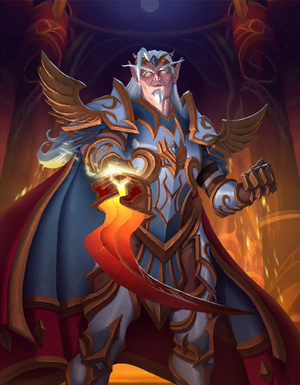
At the beginning of the Second War, the Seven Kingdoms formed the Alliance of Lordaeron. Seeking help wherever he could against the orcish Horde, Supreme Commander Anduin Lothar, a descendant of King Thoradin, used the ancient oath sworn to the ancient Arathi bloodline by the kingdom of Quel'Thalas after the Troll Wars. However, this call to war was met with mixed feelings by the quel'dorei, and High King Anasterian Sunstrider did not consider the orcs a threat. He sent only a small elven fleet to the Alliance, commanding the rest of his forces to stay in Quel'Thalas. Some high elves, however, disobeyed the king's orders, choosing instead to join in the fight against the orcs. Their leader was the renowned ranger captain Alleria Windrunner, and though he was disappointed with the generally poor response from Quel'Thalas, Lothar nonetheless welcomed with open arms the elves; they would serve a much-needed role as archers, scouts, and mobile support troops.[48]
In order to win the support of Warlord Zul'jin and the Amani Empire, Warchief Orgrim Doomhammer promised that the orcs would help them annihilate their rivals, the high elves of Quel'Thalas.[49] After Gul'dan corrupted one of the Runestones, disrupting the magical barrier Ban'dinoriel that weakened the orc and troll's powers,[50] the Horde's forces stormed toward Silvermoon City. They terrorized the countryside, pillaging the elven settlements and cutting down every elf they found. In the capital, Alleria met with High King Anasterian and urged him to pledge his forces to the Alliance of Lordaeron, but he needed little convincing. Not since the ancient Troll Wars had the elves died in such numbers, and though the Alliance and the elves were now unified in purpose, any hope that they had of a quick victory vanished when the enslaved red dragons arrived. A firestorm enveloped the forests around Quel'Thalas, and caused most of the elf defenders to seek shelter in Silvermoon City. The quel'dorei had no physical weapons that could stop the invading orcs and their dragons, but their sorcerers still managed to summon an immense shield around Silvermoon City with the Sunwell's power.[51]
Simultaneously as the Amani trolls continued their siege of Quel'Thalas, the Old Horde splintered under internal political pressure. While the Alliance of Lordaeron was besieging Blackrock Spire, High King Anasterian led efforts to drive the trolls and while the battles were costly, the elves managed to secure their homeland. The Second War was won, and victory celebrations graced every Alliance city, where humans, dwarves, gnomes, and high elves reveled in their triumph. However, hatred of the orcs still burned in the hearts of many, and groups of elves and various races stalked the Eastern Kingdoms in search of their prey. They captured many of the orcs they found, or killed them on sight, their vengeance for loved ones who had died in the war.[52] Two years after the war, Alleria Windrunner and her elite cadre of rangers accompanied the Alliance Expedition on Draenor, determined to avenge Quel'Thalas,[53] and were ultimately believed dead after the destruction of Draenor.
In the following years, relations between the humans and the elves began to sour.[54] The quel'dorei, who had been reluctant members of the Alliance in the first place, retained little interest or investment in its affairs, such as upkeeping the internment camps and defending Nethergarde Keep, but that was as much from their fascination with all magic as from any desire to help humans.[55] Slowly, they began to doubt the value of the Alliance, as humanity seemed to need the high elves, but had little to offer in return.[33] High King Anasterian himself felt betrayed by the Alliance's retreat to Capital City during the war, which left the elves to deal with the rampaging Amani trolls alone. The elven king claimed that the Alliance had abandoned Quel'Thalas in its darkest hour, and while not all of the high elves agreed with him, enough did.[52] When he withdrew his nation from the Alliance, the official stance was that the humans' poor leadership resulted in the burning of Eversong Woods; in addition, with Lothar dead and the Horde defeated, the king believed that the debt to Thoradin and his descendants was repaid. While King Terenas Menethil II reminded them that nothing of Quel'Thalas would have remained if not for the hundreds of humans that gave their lives to defend it, the majority of the elven race still shut themselves inside their enchanted kingdom, with a few exceptions.[9]
The Third War
- Main article: Scourge invasion of Quel'Thalas
By the time of the Third War, the high elves and humans no longer trusted one another.[56] Nevertheless, despite their kingdom's official departure from the Alliance of Lordaeron, Prince Kael'thas Sunstrider and many quel'dorei still remained in Dalaran, as most contemporary mages bowed to the sovereignty of the Kirin Tor.[57] Some also became paladins in the Order of the Silver Hand, such as Mehlar Dawnblade, a pupil of Uther the Lightbringer.[58] The altruistic priests of Quel'Thalas refused to abandon their roles as healers and remained in Lordaeron despite the edicts from their masters in Silvermoon.[10] They later joined with Prince Arthas Menethil and Jaina Proudmoore in investigating the Plague of Undeath, with the goal of healing the land of its strange curse.[59]
Following the Scourging of Lordaeron, Quel'Thalas dispatched high elf priests to help the Alliance nations defeat the undead, but nothing could stand against the undead.[60] As ordered by his master the Lich King, the death knight Arthas soon turned his sight on Quel'Thalas. They needed the Sunwell to revive the necromancer Kel'Thuzad, who would then summon the demon-lord Archimonde into Azeroth.[61] Rumors of Arthas's patricide were beginning to spread, but the elves did not connect this to the plagued grain epidemic.[25] When the undead entered into the Eversong Forest, High King Anasterian Sunstrider left the task of organizing the defenses and leading the military to Ranger General Sylvanas Windrunner. She ordered most of the kingdom's magi and priests to gather in Silvermoon City, while she took the Farstriders outside to mount a fierce resistance. Nevertheless, despite their tactics and magic, the high elves were pushed back from the outer to the inner elf gates, and Sylvanas knew her only hope was to buy the capital's defenders time to prepare for a siege.[62] During the invasion, Arthas raised the fallen members of Sylvanas's army either as incorporeal banshee or as intact bodies. These fallen high elves would become known as Darkfallen, prowling the lands as either dark rangers or blood mages for the Scourge.[63]
The Scourge would have been unable to pass the Elfgates if not for the betrayal of Dar'Khan Drathir, an esteemed magister who joined the cause of the Lich King in exchange for all the power and recognition he had always craved for, and who betrayed his entire race by destroying Quel'Thalas's magical barriers.[64] During a final stand outside the city, Sylvanas bravely faced Arthas but was unable to match the power of Frostmourne. According to Arthas, it was Sylvanas who brought doom on the high elven people; initially, his only goal was reaching the Sunwell.[65] The official story given by the high elves had the Ranger-General having perished valiantly in battle against the undead, and her body being burned to ashes in the fire that had devastated half the capital.[66] In truth, the death knight punished Sylvanas for her defiance, ripping the high elf's spirit from her body and converting it into a spectral banshee.[62] She was then forced to take part in the assault on Quel'Thalas and murder her own people— the very people she had sworn to protect to the end of her days. While the defenders held off the undead, an evacuation ship was ordered to take many quel'dorei children to safety with the Wildhammer dwarves in the Hinterlands. Unfortunately, the ship was attacked and sunk by gargoyles, leading to the death of all the children and refugees on board.[25]
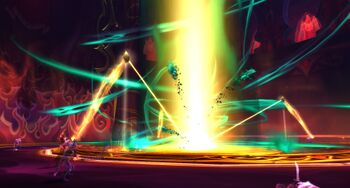
Overwhelmed, High King Anasterian and the surviving elves gathered aboard their fleet and retreated to the Isle of Quel'Danas. Protecting the Sunwell became their primary focus, they could always rebuild their capital but the fount of arcane magic was irreplaceable. When the Scourge shattered the capital's defenses, they cut a path north toward the island, slaughtering the population and prominent figures such as High Priest Vandellor, Grand Magister Belo'vir, and the Convocation of Silvermoon. Even the elven king and his ancient sword Felo'melorn fell under the weight of Frostmourne; morale crumbled among the remaining high elf defenders and very few escaped as the Scourge swept over Quel'Danas. Victorious, Arthas reached the Sunwell and resurrected Kel'Thuzad into a lich, which came at great cost, as the ritual befouled the Sunwell with corrupted energies that gradually permeated the lands of Quel'Thalas, the surviving quel'dorei, and everything they had ever built. The death knight then gathered the Scourge and marched south toward Dalaran, leaving only ruins and death in his wake.[67]
When Prince Kael'thas returned from Dalaran, he surveyed Silvermoon City's ruins and attended his father's funeral, succeeding him as leader of a kingdom on the brink of extinction. The surviving elves greeted their prince with thinly veiled resentment, and Kael'thas made no excuses for being absent in Quel'Thalas's hour of need.[68] Soon discovered that the greatest danger to his people was not the Scourge remnants, but the Sunwell itself. Given enough time, the necromantic energies would kill them all, and Kael'thas painfully concluded that the Sunwell, the heart of their society, had to be destroyed. With the aid of the most powerful remaining magi, who had come to the same conclusion, Kael'thas executed a plan that would irrevocably change the fate of his people, and succeeded in destroying the Sunwell through a great ritual. Though he had saved his people from continued exposure to the dark energy, the destruction of the Sunwell resulted in a withdrawal-based lethargy for the elven race. In the end, only about ten percent of the entire race survived the genocide.
Prior to the Siege of Dalaran, Lady Jaina Proudmoore worked tirelessly to rally as many refugees as she could. When she set sail for Kalimdor, her forces included members from nearly every Alliance race, including survivors from Quel'Thalas.[69] As the second greatest concentration of high elves, Dalaran was destroyed as well, and most of them died under Archimonde's attacks.[12] In Kalimdor, several high elven priests joined the Human Expedition and the Kalimdor alliance to fight the Burning Legion.
Rise of the blood elves
- Main article: Blood elf
In the aftermath of the Third War, the surviving high elves were somewhat scattered, grieving for the decimation of their homeland. The loss of the Sunwell was immediately felt, and the pangs of addiction would only grow more debilitating as time passed, leading many quel'dorei to fall ill and lethargic.[68] Though Prince Kael'thas Sunstrider was troubled by this new development, as long as the Scourge roamed the nearby land, his people would never know peace. Subsequently, Kael'thas rallied the survivors and joined with Lor'themar Theron who had done the same across Quel'Thalas. Under their prince's leadership, 90% of the survivors took the name "sin'dorei" (children of the blood in Thalassian), to remember the death of their king and brethren.[2]
In time, the blood elves fought to reclaim a small portion of Silvermoon, but most of the city and their land, in general, was haunted and overrun by lingering undead, while their buildings remained in ruins and vengeful Amani trolls began striking out again.[14] Around 15% of the newly-named sin'dorei, led by Prince Kael'thas himself, started traveling throughout the land in order to find more surviving elves and to find a source of magic to replace the destroyed Sunwell. Due to the unreasonable orders of Grand Marshal Othmar Garithos, the leader of the Alliance resistance who had felt wronged by the high elves' conduct in the past,[70] the prince's people were forced to ally themselves with the naga of Lady Vashj and fled to Outland. They soon joined Illidan Stormrage who taught them how to sate their hunger for magic by feeding on alternative sources, having himself suffered the same withdrawal for thousands of years. Subsequently, the blood elves began to hunt and use demons in order to steal their powers, although Kael'thas's alliance with Illidan and worse, his new reliance on fel magic, was kept a secret from most of his brethren back home.
Most of the remaining "high" elves who had chosen to remain with the Alliance following the Second War did not return to their kingdom after the Third War.[9] When Grand Magister Rommath returned to Quel'Thalas to teach them Kael's magic siphoning ways, some elves were disgusted by the practice and refused siphoning magic from living creatures. Unable to lead a divided nation, Regent Lord Lor'themar exiled the dissenters from the kingdom, the exiles finding residence in Quel'Lithien.[16]
A few high elves rejoined the Alliance in recent years, but the Alliance as a whole remains somewhat suspicious of high elves to this day, as their secession after the Second War left bitter memories. Furthermore, the night elves, who became part of the Alliance during the Third War, saw it as their duty to warn their new allies against the high elves. The Highborne's part in bringing about the War of the Ancients figured heavily in the night elves' retelling of high elf history.[2]
World of Warcraft
Years after the Third War, the high elves were in a state of diaspora. Most resided in human cities like Stormwind City and Dalaran. Others live in seclusion in the wild forests, often in hunting lodges such as Farstrider Lodge. Several high elves have also integrated into Theramore under the leadership of Lady Jaina Proudmoore.
Deep within the Hinterlands, the Highvale elves of Quel'Danil Lodge used their outpost as a center of communication, while their ambassadors were working to establish diplomatic relationships with other races of the Alliance, with whom they shared their knowledge of the Witherbark trolls that inhabit the area in the southern Hinterlands.[71] In time, they made an alliance with the Wildhammer dwarves, much to the ire of their common enemy, the Revantusk trolls. Otho Moji'ko of the Revantusk Tribe instructed Horde adventurers to slaughter as many Highvale elves as possible,[72] while Oran Snakewrithe enlisted the same adventurers to burn documents that recorded the Highvale elves' communications with the other races and other information. However, their actions were unsuccessful, as the Highvale elves still retained the documents, which also included deaths, births, and seasons.[73]
At some point, Quel'Danil Lodge was plagued by a series of mysterious deaths, where the young rangers turned up dead with no signs of struggle or trauma. The high elves initially thought this was assassination from the Witherbark or Revantusk tribes, but concluded it was supernatural when they discovered the victims' faces twisted in terror, while a few of their healers have been stricken and nearly died themselves after merely handling the remains. Because their magics have been ineffective, Magister Falath traveled to the Hall of Mysteries of Ironforge as the lodge's emissary, where he petitioned for the aid of the paladins of the Order of the Silver Hand. The paladin adventurer later discovered that a Vengeful Spirit was responsible and exorcised it.[74]
In the Plaguelands, High Priestess Aurora Skycaller, originally found in Northpass Tower helped the Alliance adventurers to recreate the Crystal of Zin-Malor. At some point, Nathanos Blightcaller sent Horde adventurers to ransack the Quel'Lithien Lodge in order to recover the Quel'Thalas Registry, which contained his true identity before he became undead.[75]
A small unit of high elven rangers under the command of Ranger Captain Fellari Swiftarrow fought together with the zealous Scarlet Crusade against the undead for a while, though they were lost in battle in the Silverpine Forest. A large statue in honor of the capable elven leader was erected in the Scarlet Monastery.
Several high elves became assassins of the Cult of the Dark Strand in Kalimdor, while some joined the Scholomance, the school of necromancy on Caer Darrow.
The Burning Crusade
During the Invasion of Draenor, Lieutenant Talthressar of the Sons of Lothar played a key role in the construction of Allerian Stronghold in Terokkar Forest. The high elf proclaimed that the founding of the keep was a symbol of the alliance between high elves, humans, and dwarves, and would mark the sacrifices of Kurdran and the Wildhammer clan in their hunt for Ner'zhul.[76]
Twenty years later, with the reopening of the Dark Portal, the remnants of the Alliance Expedition's high elven ranger cadre were reconnected with Azeroth. After learning of the Scourge invasion of Quel'Thalas and their brethren's allegiance to Prince Kael'thas Sunstrider and the Horde, many of them chose to remain in Outland.[77] Among them, some remained stationed at Allerian Stronghold under the lead of Captain Auric Sunchaser, while others took refuge in Shattrath City. In time, the Alliance used the Allerian Stronghold as their base of operations in Terokkar Forest, and from where they focused on fending off the hostile arakkoa, Firewing blood elves, remnants of the fel orcs, and the Shadow Council.
In the Shadow of the Sun
Sometime before the war against the Lich King, Ranger Lord Renthar Hawkspear, leader of the Quel'Lithien Lodge high elves, and High Priestess Aurora Skycaller were approached by Regent Lord Lor'themar Theron. Though initially under the impression that Lor'themar had come to apologize on behalf of Kael'thas Sunstrider, they were taken aback to learn of the Prince's demise. When Renthar asked who would take the crown of Quel'Thalas, Lor'themar replied that none remained with a right to it.
After Lor'themar referenced the slightly better state of the Ghostlands and offered the quel'dorei aid and supplies, Renthar angrily declined his assistance and revealed that the Regent Lord had banished the quel'dorei of the lodge from Quel'Thalas, as he could not afford to lead a people divided. In addition, Hawkspear spoke of Horde agents who had ransacked the lodge and killed several rangers, in the name of the Banshee Queen's champion, Nathanos Blightcaller. He stated that by rights he should send Lor'themar's head to Sylvanas Windrunner, though ordered him to leave instead.[16]
Wrath of the Lich King
After the defeat of Kil'jaeden, the blood elves took the Sunwell back with the help of the Shattered Sun Offensive, and the high elves were allowed to share the Sunwell. Captain Auric Sunchaser from the Alliance Expedition rangers represented the high elves at the well itself, and a number of high elves have been permitted to make pilgrimages to the restored fount of power.[78]
Once Kael'thas Sunstrider was defeated, the blood elves began seeking representation in Dalaran. When the Kirin Tor proclaimed themselves neutral in the conflict between the Horde and the Alliance, and instead sought to help bridge the gaps between the two factions, they started by reaching out to Quel'Thalas for magical support against Malygos.[16] Consequently, the elven population of Dalaran underwent something of a split: the portion of the elves who converted to the blood elven philosophy took up the name of the Sunreavers, named for their leader, Aethas Sunreaver, the only non-human on the Council of Six at the time who ensured the Horde a sanctuary within the city. Conversely, the high elven members who opposed the notion of allowing the sin'dorei back into the Kirin Tor's ranks formed the Silver Covenant as a precaution against possible treachery from the Sunreavers.[79] Consequently, the Silver Enclave became the base of operations of the Covenant, and later of the Alliance in Dalaran. However, their leader Vereesa Windrunner held no political sway within the city, thus the blood elves were officially readmitted as members of the Kirin Tor.[80]
As the Silver Covenant wasn't delighted having the Horde in Dalaran, with Garrosh Hellscream leading the charge in Northrend, many high elves aligned themselves with the Alliance,[79] and joined the Alliance Vanguard during the Alliance's war against the Scourge. Some of their members joined the ranks of the 7th Legion as battle mages, now stationed at Wintergarde Keep in the Dragonblight, with Vas the Unstable as their representative. They later represented the Alliance from the Silver Covenant Pavilion in the Argent Tournament.
While some high elf communities, like the one at Quel'Danil Lodge, have managed to maintain their stocks of dragonhawks,[5] their exile from Silvermoon has made these animals much harder to come by. Fortunately, the Silver Covenant seems to have won the trust of the companions of their ancient ancestors: the hippogryphs. The intelligent creatures have apparently decided that the high elves are worthy of a partnership, serving as mounts and flight path conveyance from their outposts.
Cataclysm
By the time of the Cataclysm, a group of draenei moved into the Hinterlands under the leadership of Ambassador Rualeth and joined the Highvale.[81] As part of the Forsaken offensive throughout Lordaeron, Quel'Danil Lodge came under attack. With the help of adventurers, the high elves and the draenei settlers were able to repel the invaders.[82] The Highvale documents were also retrieved from the chaos by Alliance adventurers and safely delivered to Anchorite Traska.[83]
At the same time, all the high elves at the Quel'Lithien Lodge became wretched after Ranger Lord Hawkspear found an item of seductive energy.[84] Only Kirkian Dawnshield, Kriss Goldenlight, and Hawkspear himself managed to escape their fate. While Dawnshield chose to seek out assistance, asking adventurers to put his family out of their misery, Hawkspear was apparently focused on destroying the undead, awaiting for people to help him in that purpose, but none have yet to make such an offer.
A retelling of elven history concerning the Crystal of Zin-Malor could be undertaken in Winterspring, addressing the intertwining plights of the Highborne, their fallen quel'dorei descendants, and the recent venture of a blood elf Farstrider regiment which met its end at Lake Kel'Theril. Their stories were told by the Kaldorei Spirit, the Quel'dorei Spirit, and the Sin'dorei Spirit.[85]
The word of a new threat from Zul'Aman prompted Ranger-General Halduron Brightwing and Chieftain Vol'jin to fight against the reinvigorated Amani Empire. Against the wishes of Silvermoon's Regent-Lord Lor'themar Theron, Halduron personally invited Ranger-General Vereesa Windrunner and her Silver Covenant rangers to compensate for the lack of available Farstriders. Their presence was not well received in the upper echelons of Silvermoon City, but Vereesa declared that Quel'Thalas was as much her home as it is their, and that she would not see it fall to their ancient enemy. To end the debate, Halduron stated that his role as Quel'Thalas' ranger-general permitted him to seek aid wherever needed to keep his homeland safe. While this event may have showcased the cooperation between high and blood elves, their future reunification appeared to remain elusive.[86]
Mists of Pandaria
During the attack on Theramore Isle, a number of high elves of the Silver Covenant were present to protect the city. After Thalen Songweaver escaped from Theramore, Ranger-General Vereesa Windrunner led her soldiers to the western part of Dustwallow Marsh.[87]
At the time of the discovery of Pandaria, Jaina Proudmoore soon discovered that the Sunreavers helped Warchief Garrosh Hellscream to steal the Divine Bell, using Dalaran portals to infiltrate Darnassus,[88][89] which led to the conception of the mana bomb that destroyed Theramore Isle. Consequently, she mobilized the Kirin Tor, Alliance forces, and the Silver Covenant to purge the Horde from Dalaran.[90] Though Aethas Sunreaver claimed he knew nothing of Garrosh's scheme, Jaina incarcerated him and his Sunreavers after he refused to order his people to leave the city peacefully. Various high-ranking high elves were slain by Horde agents who sought to free the imprisoned Sunreavers and their leader, including Sorin Magehand, Arcanist Rathaella, and Mage-Commander Zuros. During the chaos, Grand Magister Rommath noted that it unsettled him to fight directly with the high elves of the Silver Covenant. The Silver Covenant also cut off the Sunreavers means of escape, to prevent any from leaving, and those that surrendered were imprisoned in the Violet Hold,[91] while those who resisted were put to the sword,[92]. The Silver Covenant also took the opportunity to remove any rivals that sided with the Sunreavers, as well as seize their assets,[93][94] thereby leaving the high elves the sole elven population living freely in the city.
The purge also put an end to Dalaran's alliance with Silvermoon, which had stood for over 2,000 years.[43] Shortly afterward, the Kirin Tor Offensive, comprising of Silver Covenant high elves and Kirin Tor war mages, was formed by Jaina, intending to seize Thunder Isle and prevent the Sunreaver Onslaught from claiming powerful artifacts from Lei Shen.[95]
Legion
During the third invasion of the Burning Legion, Vereesa Windrunner led the Silver Covenant to Trueshot Lodge, pledging their aid to the new leader of the Unseen Path following their inauguration.[96]
During the Nightfallen rebellion, along with Tyrande Whisperwind and her Sentinels, Vereesa led a group of Silver Covenant war mages to Suramar to support the Nightfallen rebels in their attempt to reclaim the city from the Burning Legion. A formal, if tense, truce was later made between the Alliance troops and the Horde forces led by Lady Liadrin and Grand Magister Rommath.[97] In time, the combined elven army fought its way to the foot of the Nighthold itself, where the kaldorei, sin'dorei, quel'dorei and shal'dorei rebels were confronted by Grand Magistrix Elisande. As she turned to address Vereesa, Elisande derided the quel'dorei as "peasants playing at nobility", unworthy of the name high elves, and mocks their tendency to "mingle" with lesser races that dilute their bloodline. The Magistrix of Suramar then unleashed her time magic, trapping the entire elven army in a time stasis.[98] They were later freed after Elisande's defeat at the hands of the adventurers.
In time, some high elves joined the reformed Order of the Silver Hand as Silver Hand Shieldbearers. High elven war priests could also be found fighting demons during the Legion Assaults.
After the ren'dorei led by Alleria Windrunner joined the Alliance and made Telogrus Rift their base of operations, a few High Elf Wayfarers have traveled there to study the Void.
Battle for Azeroth
During the events of the Fourth War, some high elves could be seen during the Island Expeditions, such as the Auric's Angels, to either be helped by adventurers or to engage the Horde.
A few high elf forces participated in the Battle for Stromgarde, and Yvera Dawnwing helped teleport Alliance forces from Boralus to Stromgarde Keep.
During the battle at the Gates of Orgrimmar, Alleria and Vereesa Windrunner, leading the Silver Covenant forces, supported the Alliance in front of the Horde's capital with high elven ballistae.[99]
Shadowlands
During the Scourge resurgence across the world, Justicar Mariel Trueheart called on their allies of the Silver Covenant to stand against the undead.[100] The high elves were later seen among the defenders of the Argent Tournament Grounds in Icecrown. At the request of the Argent Crusade, the Covenant also had to welcome the Alliance adventurers and ensure that each of them was fully aware of the risks involved in fighting against the unleashed Scourge.[101]
Following the war against the Jailer, the brothers Bronzebeard reported that while the Sunreavers were allowed to return into the ranks of the Kirin Tor, the Silver Covenant was still watching them like hawks.[102]
Appearance
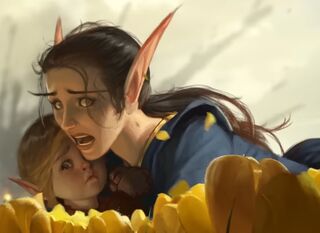
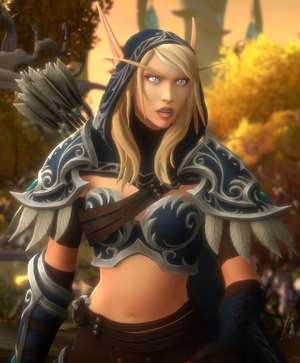
In World of Warcraft, the high elves resemble blood elves appearance-wise, as biologically and physiologically they are the same race.[15] Lore-wise, it is not uncommon for high elves to be mistaken for blood elves. Taela Everstride at Allerian Stronghold even says, somewhat bemusedly, "No, don't feel bad. I get that a lot... I'm a high elf, not a blood elf. Don't worry, I won't suck the magic out of you." Other than greeting voices, both high and blood elves appear to share similar voice emotes in-game, particularly during combat.
Like the other elves, they have unusually acute senses and are able to see clearly even in low-light conditions with their keen sight. Their sharp eyes can notably see farther than those of humans.[103] As a general rule, elves are also slim, athletic, and graceful.[15] They are taller than most humans.[3] On average, high elven women are 5'9" tall while high elven men usually stand around 6'3" in height,[104] with males typically having slender, muscular, and athletic bodies. Like all elves, they are considered highly attractive by the standards of most mortal races.[103][105]
They typically have fairly long hair, and generally do not grow their facial hair to gigantic proportions until old age. They possess long pointy ears, and while night elves have long, slanted ears while high elves' ears are shorter and tend to point upwards. Furthermore, their pointed ears have been greeted with admiration or mockery by other races.[15] Their hearing is so sharp that they can pick up the sound of a butterfly landing on a nearby flower.[3] Humans and dwarves often make fun of their ears by comparing them to those of donkeys, swine, or—worst of all—goblins.[106]
Since the night elves sacrificed their immortality and much of their power at the end of the Third War, all elves are now mortal and have comparable lifespans that can extend as long as several thousand years.[15] It appears that physical maturation is roughly on par with human aging, as seen with several young elves, though only up to a point. The aging process appears to even out at around their physical peak before their aging becomes more sporadic and typically elven. How fast they age precisely is unknown, but the oldest of their kind seem to be roughly 3,000 years old, since High King Anasterian Sunstrider was extremely long-lived, having presided over a number of long-standing conflicts and died in around his three-thousandth year. By this time, his physical appearance had become elderly and wizened, suggesting that typical blood/high elven old age is induced around that time period. Lady Liadrin specifically attributed his elderly appearance to his 3,000 years of age.[25]
High elves typically have light-colored eyes that vary from light grey to blue to green, occasionally brown[107] and grey,[7] with the unique case of King Anasterian and his gold eyes in Reforged. In Warcraft II: Tides of Darkness, the "Ranger Scouting" upgrade for the Elven Ranger shows an eye with a green pupil. In Warcraft III: Reign of Chaos, high elven eyes were depicted as white and pupil-less, both in-game and in official artwork. In Shadowlands, the blue eyes and light skin's customizations were added to give both blood elves and void elves characters the high elf customization options. During patch 9.0.1, Vereesa Windrunner and all high elves had purple eyes, but it was a bug, which was reverted for patch 9.0.2. In the process of tracking the bug down, it was decided to give purple eyes to playable blood elves and void elves, but these were a different set of eyes than the ones removed.[108][109][110]
Population
Surviving high elves comprise a mere 1% of the original high elven population, with the blood elves accounting for the remaining 9% of it.[2][13] Since Kael'thas took 15% of the blood elves to Outland[13] (i.e. 1.35% of the original high elf population), and since Kael'thas' army numbered at least 2,000[111] it follows that the total high elf population is currently at least 1,481, and was at least ~148,000 prior to the Third War. As a people, the high elves are all but extinct: the remnants of the remnants of a fallen race.[19]
In relation to the playable races, Blizzard has stated that the high elves have a considerably smaller population than even the Gnomeregan Exiles.[70] High elves are a rare sight even in Alliance lands,[112] and are considered a fallen, all-but-extinct race.[113] With the destruction of both Theramore and Quel'Lithien, the bulk of the remaining high elf population appears to be bound to the Silver Covenant in Dalaran, the Allerian Stronghold in Outland, and the Quel'Danil Lodge in the Hinterlands.
According to Vereesa Windrunner, high elves seldom give birth and very rarely give birth to twins.[114]
Culture
“With the Sunwell to protect us, our kingdom is invincible.”
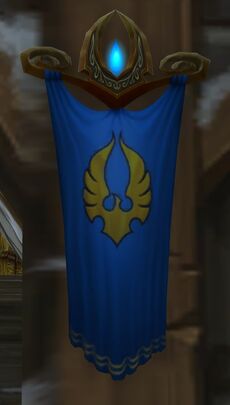
Quel'Thalas was the fruit of its founder's quest to reignite the Highborne culture, and High King Dath'Remar Sunstrider intended it to dwarf the night elves' civilization and stand as a monument to the ages.[115] At the height of their glory, the high elves prospered in the Sunwell's glow, their way of life only made possible due to its energies empowering the magi who built the kingdom, enabling many of the spells that informed their day-to-day lives, as well as providing great protection over their capital. The Sunwell was bound to all quel'dorei, feeding them magic unceasingly,[14] and their entire culture revolved around it.[116]
Magic played a central role in the elven kingdom, being as essential as eating or breathing.[25] Prince Kael'thas Sunstrider described magic in Quel'Thalas as all-encompassing, the birthright of every citizen.[117]
High elven society in Quel'Thalas was highly regimented, and it was difficult for individuals to move beyond their caste.[118]
Throughout their history, high elves were known to be largely insular and isolationist.[25][68] According to Jaina Proudmoore, they also seemed to think themselves superior to all humans, regardless of rank and nobility.[105] Among them, Alleria Windrunner notably chafed at the stagnation of Quel'Thalas and wished to see the world beyond; to meet other races and experience other cultures. On the other hand, her mother, Ranger-General Lireesa, held to the high elves' isolationism, believing that all that mattered laid in Quel'Thalas.[119]
Once, Quel'Thalas used to host bright, pompous ceremonies with mock battles and pageantry. However, in the wake of the various tragedies suffered by their race, the high elves who renamed themselves blood elves have become embittered and now view such excessive displays as distasteful.[120] One high elven celebration was the Remembrance, which commemorated the anniversary of the Troll Wars' final battle.[121]
High elven architecture is of the same illustrious and elegant design as it was when Dath'Remar Sunstrider founded Quel'Thalas. It involves pendulous creations of wondrous curves and columns, their designs involving natural, floral, flowing, and animal motifs. Their fountains seem to defy physical boundaries, creating or warping water in impossible ways.
Like dwarves, they can be far more patient than humans and are able to remain alert and ready to act even after hours of waiting.[122] However, younger ones do dislike waiting as much as humans,[3] and although most outgrow their tendencies toward impatience early on, some retain the trait all their lives. The latter generally ended up living away from Quel'Thalas or taking on tasks that let them travel extensively.[123]
High elves have sensitive taste buds and dislike the taste of heartier dwarven food.[123] However, during his time in Dalaran, Prince Kael'thas noted that he appreciated the heartiness of human food and that while elven food is delicious and attractively presented, it sometimes leaves one hungry for a more substantial meal.[124]
During the Scourge invasion, Arthas mocked the quel'dorei for having a tendency to exaggerate, saying that "the elves are very fond of putting paper manes on cats and calling them lions".[125]
According to the High Elf Wayfarers in Telogrus Rift, the study of the Void is as frowned upon in high elf society as it is among the blood elves.
Most young high elves have a "I wanna be a Farstrider" phase which they outgrow by the time they're taken as apprentices, at which point they enter the "I'm going to be a magister" phase instead.[126]
High elven children would play a game called "Captive" - each turn a child would be tied up by the others. The one who would release himself in the least amount of time won.[58]
Language and naming
High elves speak Thalassian, the language of their ancient race. Individuals who are unfamiliar with the language's proper name may refer to it as "High Elven". They originally spoke Darnassian, leading to some overlap and linguistic similarities between the two languages, but with time their language evolved into the modern one. By the time of the Second War, their elder tongue had been almost forgotten.[127] Several of the common quel'dorei sayings have been translated and can be found here.
In contrast to their night elven cousins, high elven naming conventions tend to favor the concepts of the day, the sun, and brightness/light/fire over the night, the moon, and darkness. A prefix referencing one in some way ("Brightwing," "Sunhallow," "Dawnglow," "Blazefeather," etc.) is quite common in many high elven surnames. However, some others eschew this altogether and have fairly standard elven names that evoke no particular imagery; Lor'themar Theron himself is a prominent example of this.
Mounts and companions
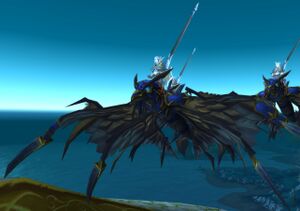
The high elves had a special affinity with dragonhawks before the Scourge attacked Quel'Thalas. The dragonhawks would often serve as flying mounts for the elves, though after the Third War they seem to have developed a preference for hippogryphs instead. The Silver Covenant Hippogryphs are notably known to be fiercely loyal to their riding partners.
Some high elves ride a special breed of horses. According to the elves, generations of breeding have created an animal far superior to its mundane cousins.[3] Members of the Silver Covenant are shown riding horned Quel'dorei Steeds, which also appeared on the sails of the Thalassian warships and on the shields of the ballistae during the Second War, indicating a proximity with the animal. They descended from a fine line of horses that once grazed near the shores of the Well of Eternity.[128]
The mana wyrms found on Sunstrider Isle were created by the high elves along with tenders and arcane wraiths, all of them bound into non-aggression and complacency by their magical skills.[129]
Combat, magic and technology
According to The Old Wizard's Almanac, the magic of the high elves is extremely powerful, as they possess a magical acumen that rivals that of any - even the humans. None were more skilled in the mastery of arcane than the high elven Magisters of Quel'Thalas.[130] They studied many years to protect their kingdom, and so weapons to bolster their skills were fashioned to assist that effort.[131] However, while they can use arcane magic, most do not because most high elves are not spellcasters.[15] After the destruction of the Sunwell, the Highvale high elves notably stopped practicing magic.[5]
During the Third War, the high elven mage-priests roamed the battlefields to cure the wounds of fallen comrades and used their Light-given powers to bolster the spirits of Lordaeron's fighting elite.[10] As agents to the Kirin Tor, the high elven sorceresses used their arcane powers to aid the Alliance in times of peril. Although their powers were not often used directly in combat, they were able to aid the Alliance warriors with a wide array of specialized conjurings and magical effects.[132] In the Halls of Magic at the mystical city of Dalaran, the elven mage-priests and sorceresses diligently studied their mysterious arts within the depths of the arcane sanctum.[133] The high elves are also proficient in archery, swordsmanship, and are known to form notoriously fine scouts.[134]
Unencumbered by helm or heavy armor, the elven archers are keen of eye and fleet of foot. Unmatched in their use of the bow, they are swift to let loose a rain of arrows upon any foe, including those that attack from the skies above.[135] The high elven rangers were formed at the time of the Troll Wars.[34] Their pursuit of mastery in longbow, marksmanship, and scouting made them more rugged and even deadlier than the elven archers - traits for which they are greatly feared amongst their enemies. Although their numbers are few, their presence could change the course of the war if they are deployed wisely.[136] Around 500 BDP, these rangers formed an organization known as the Farstriders, and their commander was given a unique, historic title: Ranger-General of Silvermoon. They have long been considered valiant and honorable elves who regarded the law with deep respect and faith. Indeed, they have long been considered the epitome of selfless dedication.[137]
Some elven rangers possess minor druidic abilities, as Vereesa Windrunner was able to use the "language of the trees, of all plants", and sense a plant's emotions and history through touch.[138]
In the Silver Enclave of Dalaran, high elf class trainers could be found teaching the ways of the priests, warriors, rogues, hunters, paladins, and warlocks[139] to the Alliance adventurers. Master Cheng is a high elf monk present at the Peak of Serenity in Kun-Lai Summit. Those who joined the ranks of the Cult of the Damned learned to master the dark arts of necromancy in the Scholomance.[140][141]
Under High King Dath'Remar Sunstrider's orders, the Magisters created a protective barrier named Ban'dinoriel ("the Gatekeeper") around the land, which prevented the Burning Legion from detecting their magic, frighten away their superstitious Amani rivals,[28][34] and weaken the magic of all non-elves within it.[142][143] Over several decades, the arcanists built a series of monolithic runestones around the borders of Quel'Thalas to mark the boundaries of the barrier.[28] The Runestones were powered by the Sunwell[144] and linked to the mother tree Thas'alah, tying the power of the tree's nature magic to the elves' arcane spells.[34]
Guard towers were used for defense in Quel'Thalas, and the high elves seemingly developed the arcane golems under the reign of High King Anasterian, although they were only seen after their conversion to sin'dorei.[145] During the Alliance-Horde war, the Silver Covenant designed several arcane guardians,[146] and an alteration of the older arcane golem named the Arcane Destroyer, which was described as a machine of death capable of inflicting massive destruction against their opponents.[147]
The elven destroyers were powerful warships from the fleets of Quel'Thalas. Crewed with highly-skilled elven seafarers, these swift-sailing vessels were prepared to engage the enemy wherever they might be found. Elven destroyers constituted a critical part of the Alliance of Lordaeron naval defense force as they could unleash their firepower upon dreaded aerial forces of the Old Horde.[148] Lord Admiral Daelin Proudmoore of Kul Tiras described them as faster and lighter than human ships; carrying fewer weapons but compensating with their speed, and therefore as excellent additions to the Alliance maritime forces.[38]
Magical addiction
- Main article: Magical addiction
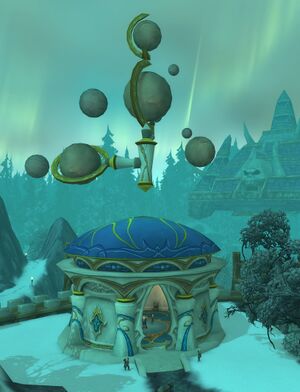
Whether or not they are spellcasters, all high elves suffer acute pangs of withdrawal in the absence of the Sunwell's energies. A crucial difference between them and the blood elves, during the time when the Sunwell was unusable, is that the high elves refused to feed their hunger for arcane magic by draining that magic from alternative sources. Without the Sunwell, a high elf might still succumb to that addiction and become one of the blood elves.[2] With the reigniting of the Sunwell, the pangs of magic addiction are being eased and more high elves are no longer tempted to succumb to it.[149]
Following the fall of Quel'Thalas, the practice of draining arcane magic from external sources, learned by Prince Kael'thas Sunstrider from Illidan Stormrage, was considered immoral by the high elves who opposed its use.[16] By embracing this technique, the blood elves prioritized their survival, health, and well-being; they believed this strength was needed to see Quel'Thalas restored.[150] By refusing, the high elves prioritized their pride and personal ethics, even to their own detriment; they believe this was the moral choice.[151]
On several occasions after the Sunwell's defilement, Prince Kael'thas publicly asserted that his people would die unless they found a new source of magic. Technically the prince was mistaken. According to Azeroth's top priests and medics, the only high elves to perish due to magical withdrawal have been the very old, the very young, and elves who were already in poor health. Such a low rate of attrition might be considered an argument in favor of simply forgoing magic and suffering through the consequences. Indeed, a few high elves are said to have succeeded in taking this route through sheer willpower: they survived the process, however unpleasant. Apparently, certain magical artifacts also ameliorate the symptoms of withdrawal and might, if sufficiently powerful, be able to suppress them altogether. This is not to say, however, that withdrawal from magic would leave the high elves unharmed. On the contrary, permanent mental or physical damage is possible.[2]
The high elves in Allerian Stronghold used draenei artifacts containing raw, magical energy to resist the lure of demonic magic.[152] The high elves at Quel'Lithien Lodge found an item of seductive magical energy and succumbed to their addiction, becoming wretched.[153] Vereesa Windrunner received help from her husband Archmage Rhonin to recuperate from the magical withdrawal.[118]
Beliefs and practices
In defiance of kaldorei traditions, the high elves rejected the old ways, the goddess Elune and the moon, choosing instead to embrace the sun,[25] but they don't see it as a god.[154]
Like the humans and dwarves with the Church of the Holy Light, many high elves are followers of the Light and Quel'Thalas also had its own priesthood.[10] Although the clergy had no known name, the ranks within them were made up of apprentices, priests, and high priests.[25] Ill-suited for the rigors of combat, the priests' role was to preserve life and illuminate their comrades in the splendor of the Light.[155] The technique of channeling the positive energies into healing energy waves was notably developed first by the high elves, and later taught to humans.[10] By the time of the Third War, Vandellor and Liadrin had the respected rank of high priests in Quel'Thalas,[25] and some high elves were even part of the original Order of the Silver Hand.[156]
However, many of the Light-wielding elves suffered a mass loss of faith during and after the fall of Quel'Thalas. Renaming themselves the blood elves, many of them swore off the Light, condemning it as a fickle thing that had faltered in the defense of their people during the undead onslaught.[157] Some high elven priests and paladins survived the Scourging of Quel'Thalas, or were not present during its destruction.[9]
The Silver Covenant also uses the symbol of the phoenix on its banners (a golden phoenix on a blue background), but given their architecture is simply recolored from existing blood elf designs, it is unclear what, if any, meaning this has to them.
Relations
With the Alliance races
The high elves were, at best, reluctant members of the original human-centric Alliance of Lordaeron,[9] and their partnership was a cold and distant one. At their head, High King Anasterian Sunstrider and the Convocation of Silvermoon were particularly unenthusiastic allies, caring little for the world outside Quel'Thalas and only agreeing to join the Alliance because of a pact made long ago to the line of King Thoradin; and even so, the high elves seceded soon after that pact was fulfilled. After officially departing from the Alliance, the high elves shut themselves off in their enchanted kingdom, and the few who remained with the Alliance did so against the orders of their reclusive masters in Silvermoon City.[10]
Humans and high elves have a long history. They fought the overwhelming Amani Empire together in the Troll Wars, the monstrous Orcish Horde in the Second War, and horrifying nightmares of the Burning Legion and Scourge in the Third War. The high elven nation's conduct at the end of the Second War led to bitterness and resentment toward the elves, but humans are also amongst the few races to accept the high elves into their cities; they can currently be seen occupying Stormwind City, and once inhabited Theramore Isle before its fall, where many high elves joined the Theramore military. Among the Seven Kingdoms, the high elves have the closest relationship with the Magocracy of Dalaran, where high elves have been allies and productive members of the Kirin Tor for over 2,000 years.[43] The high elf prince Kael'thas Sunstrider even served on its ruling council, and it was not uncommon for high elf mages to study, serve, and even live in Dalaran in addition to Quel'Thalas. Others like Grand Magister Rommath spent much of his life in Dalaran as a high elf, while Vereesa Windrunner was married to its leader, Archmage Rhonin. Since its reconstruction and relocation, Dalaran City serves as a home for the Silver Covenant, the most prominent group of modern high elves.
High elves have been known to rarely intermarry with other races, most notably with humans, and the half-elves are the hybrid offspring born from their union. Since the marriages between the two races are very rare in the annals of history,[158] their half-breeds are rare to the point that the blue dragon Kalecgos cannot pass unnoticed in his half-elf form, since there aren't a lot of them on Azeroth.[159] According to Vereesa Windrunner, any evil seeker of magic would use the crossbreeds of a powerful wizard and a high elf for their own interests, as they have so much potential in their bloodlines.[160]
The high elves are among the only other peoples that the Wildhammer dwarves truly trust.[161] During the Scourge invasion, the high elves planned to send their children to seek refuge with the dwarves in the Hinterlands even though the elves had already left the Alliance of Lordaeron.[25] Following the Third War, the Wildhammer dwarves of Aerie Peak began an alliance with the high elves of Quel'Danil, much to the ire of their common enemy, the Revantusk trolls.[72]
Following the Cataclysm, the Highvale high elves developed a bond with a group of draenei who settled at Quel'Danil Lodge, the latter being there to train in the ways of the Light and enjoy the peaceful beauty of the Hinterlands.[162]
Although no high elves were present in the ritual which created Umbric's void elves, there are those among the quel'dorei who interact with the ren'dorei. They can be seen both in Telogrus Rift and in Stormwind City, walking side by side.
Night elves
The high elves and the night elves collaborated at least once in the millennia between the Great Sundering and the modern age. Emmarel Shadewarden of the Unseen Path notably fought during the Troll Wars alongside Talanas Windrunner, the first Ranger-General of Silvermoon.[163] When she was still alive, the Darkfallen Ranger Captain Areiel met Shandris Feathermoon in unknown conditions around two or three thousand years ago.[164]
High elves have traditionally gotten along quite poorly with night elves due to their complicated and turbulent past. In the past, a particularly lingering grudge existed between the kaldorei and their Thalassian descendants, night elves generally viewed the high elves and blood elves with disgust, suspicion, or outright hostility.[15] As the night elves hold disdain for the arcane-using blood elves, so they hold disdain for their high elf cousins. This argument is questioned, though, by the fact that Tyrande Whisperwind had no problem whatsoever working with the blood elves and Kael'thas Sunstrider when she hunted Illidan Stormrage in the Plaguelands. Kael'thas seemed to feel honored by the night elves' presence. This one instance of smooth cooperation between the races might be an exception caused by each party's need for survival against the Scourge in Silverpine Forest and the ruins of Dalaran.
Following the Third War, some exiled high elves chose to rejoin the Alliance, and the night elves were among their greatest critics. While the traditional allies of the Alliance treated the high elves to a cold reception and suspicion due to their secession after the Second War, the night elves took it upon themselves to warn their allies against the high elves. The Highborne's part in bringing about the War of the Ancients notably figured heavily in the night elves' retelling of high elf history.[2]
However, the presence of night elves in the Silver Covenant settlements,[165] while the high elves were allowed inside Darnassus,[166] prove that relations seem to have improved in recent years. As the leader of the Silver Covenant, Vereesa Windrunner attended the wedding of Tyrande Whisperwind and Malfurion Stormrage with her husband and half-elf sons,[167] while her quel'dorei troops later shared a camp with the kaldorei forces with no significant tension during the events of the Nightfallen rebellion.
With the Horde races
Apart from the tauren, with whom the Highborne had had some ancient historical contact, high elves loathe the majority of the Horde's races, having fought against trolls, orcs, and undead in recent wars.
Blood elves
While high elves and blood elves are physiologically the same race,[15] high elves generally do not get along with their blood elf brethren. Following the Scourge invasion of Quel'Thalas, the practice of draining arcane magic from external sources, learned by Kael'thas Sunstrider from Illidan Stormrage, was considered immoral by the high elves who opposed its use. Unwilling to lead a nation divided, the newly-named regent of Quel'Thalas, Lor'themar Theron, chose to exile the dissenters after the return of Grand Magister Rommath from Outland.[16] By embracing this technique, the blood elves prioritized their survival, health, and well-being; they believed this strength was needed to see Quel'Thalas restored, as the kingdom had remained a wasteland while the elves were weakened by their addiction.[168] By refusing, the high elves prioritized their pride and personal ethics, even to their own detriment; they believe this was the moral choice. This schism, exacerbated by the faction war, would at times divide entire families, such as Talithar Swiftwind and his wife, Vyrin Swiftwind, with Talithar mentioning how he chose his well-being and Vyrin her integrity, although they still cared deeply for each other, with Talithar ending his life and destroying a Horde warship out of conflicted feelings for Vyrin.[151]
With the betrayal of Prince Kael'thas and the restoration of the Sunwell, Lor'themar has taken steps to re-establish cordial relations between the blood and high elves. However, these efforts have had mixed results. Aethas Sunreaver, Halduron Brightwing and Tae'thelan Bloodwatcher have also expressed an interest in mending relations between the "children of Silvermoon", though to what extent appears to vary depending on the individual. The high elves, or at least Alleria's high elves, have been granted a representative at the Sunwell in the form of Auric Sunchaser.[169]
The feud between high elves and blood elves is mostly visible in the conflict opposing the Silver Covenant and the Sunreavers.[170] The tensions later reignited after the destruction of Theramore at the hands of a mana bomb created by the Sunreaver Thalen Songweaver, which costed the lives of the high elves that had settled in the port city, and Rhonin, Vereesa's husband. As such, the Silver Covenant aided the Kirin Tor and the Alliance in purging the Sunreavers from Dalaran, enforcing Jaina Proudmoore's orders.
Fel magic played no apparent role in the elves' splintering; in fact, its use was hidden from most of the blood elves.[13] Glowing green eyes is the high elven body's natural reaction to spending time around fel magic,[171] which was used in the Magisters' rebuilding efforts instead of the Sunwell's power.[172] Like the orcs, any high elf who spends enough time around fel magic will acquire glowing green eyes.
With other races
The high elves have some history with the dragons of the red dragonflight, most of whom prefer to transform into elves[173] when assuming a mortal form. It was the red dragons who gifted Quel'Delar to the high elves, as Alexstrasza personally handed it to High King Anasterian Sunstrider.[174] Her consort Korialstrasz maintained an interest in the elves' affairs, arriving only narrowly too late to save the Sunwell from Arthas Menethil and the Scourge.[14] Strangely, several dragons have used high elves as their visage form thousands of years before high elves even existed, such as Malygos, Alexstrasza, Nozdormu, and Sindragosa.
Organizations and factions
- Active
- Formerly
 Farstriders
Farstriders Magisters
Magisters Sunreavers
Sunreavers Quel'Lithien's high elves †
Quel'Lithien's high elves † Convocation of Silvermoon †
Convocation of Silvermoon † Royal Guard †
Royal Guard † Elven Defenders †
Elven Defenders † Elven Ranger Corps †
Elven Ranger Corps †
Notable
Racial offshoots
- See also: Blood elf#Ancestry and offshoots

 Darkfallen - Undead elves originally created by Arthas Menethil to serve the Scourge, they are found among the dark rangers of the Forsaken.
Darkfallen - Undead elves originally created by Arthas Menethil to serve the Scourge, they are found among the dark rangers of the Forsaken. Banshee /
Banshee /  Spectre - Incorporeal undead elves known for their unholy screams, and the unsettling ability to possess the bodies of their enemies.
Spectre - Incorporeal undead elves known for their unholy screams, and the unsettling ability to possess the bodies of their enemies. Wretched - High elves who failed to control their innate addiction to magic, overindulging in arcane sources to the point of deformity and, often, insanity.
Wretched - High elves who failed to control their innate addiction to magic, overindulging in arcane sources to the point of deformity and, often, insanity.
In the RPG
History
The ancient origin of the high elves is a legacy of tragedy and conflict, a series of events that has profoundly affected the development of the quel'dorei. The high elves are a stark contrast to their nocturnal cousins, the night elves (or kaldorei). Forsaking the night, the high elves are the descendants of the very elves who served Queen Azshara in the time of the Well of Eternity. The kaldorei regard the high elven penchant for using arcane magic as careless, akin to a foolish child playing with fire. The schism that separates the Highborne elves and the night elves is rather ancient, one so ancient that no amount of diplomacy or offerings of peace can soothe the scars of history. The high elves, however, have had generations separating them from the night elves, and no longer care for the past. Problems between the two races are usually clashes of personality, as neither tries overly hard to interact. The arrogance of the high elves led to the War of the Ancients and ultimately to the downfall of the golden age of elven civilization. Through the reckless use of arcane magic, the high elves allowed darkness to seep into the world and corrupt Azeroth. They use the genetic phenomenon that modern elves face as a testament to their views.
The high elves only helped out on a small level in the First War. After the humans were defeated and fled north through Khaz Modan, the dwarves sent emissaries to meet with the high elves and humans to discuss the threat of the Horde.[175]
Some bands of high elven survivors fled south to the Hinterlands and to the forests of Zul'Aman. Those who stay one step ahead of the trolls survive; those who do not are dead (and probably eaten by the cannibalistic trolls). Scourge patrols, hunting the elven refugees, also stalk through the land.[176]
Appearance
High elves stand slightly taller than humans do. A high elf is usually a little over 6 feet in height and weighs between 100 to 175 pounds, depending on gender. The elves are slim, with sharp symmetrical features, often an exaggeration of perfect beauty. The high elves are uniformly fair in complexion, with white to flaxen-colored hair. Their eyes are incredibly intense in color, seeming to glow with an inner light. While many high elves have blue or green eyes, violet and red are not unheard of.[177] The structure of high elven eyes (based on artwork) shows that they are generally like humans with a pupil and iris surrounded by "white" but tend to be able to see much farther than humans are capable. The life span of high elves is several hundred years. They reach adulthood at 110 years, a "venerable" age at roughly 350 years, and most dying of old age at approximately 363 years. A few may reach "venerable" age at roughly 350 years with a maximum lifespan between 354 and 390 years,[177][178] and even fewer may live as long as two thousand years.[179] Most high elves (especially those of the Alliance) do not wear red or black for fear of being mistaken as blood elves.[180] They have shorter ears and much smaller, lighter bodies than night elves. As well, their ears usually point upwards whereas those of the night elves do not.
Blood elves have glowing green eyes and their hair and skin are much paler or otherwise unnaturally colored,[181] due to the absorption of fel energies during the period the Sunwell was lost. They are considered separate due to cultural differences more so than because of physical ones.[182]
Population
Non-canonical sources[183] state that the high elven population just a few years prior was approximately 24,810 and the half-elven population was approximately 9,550, not including Theramore, Dalaran, and several less significant cities. Stormwind (pop. 200,000)[184][185] alone has the most, with a total of 20,000 high elves, and 8,000 half-elves.
Culture
The destruction of the Sunwell has forced the high elves into decline, causing them to doubt the future of their once-proud race and drawing animosity toward them from other races who feel that the high elves have betrayed the Alliance. Most of the high elves have placed themselves under a self-imposed exile, ashamed of the damage that they have wrought upon the world of Lordaeron with their abuse of arcane magic.
While humans still accept the high elves because of the aid that both races provided each other during the most recent attacks of the Burning Legion, reinforcing the same bond that they had in both the Troll Wars and the Second War, many of the other races will only deal with the high elves if absolutely necessary. This is especially true after the acts of Kael'thas Sunstrider. The night elves, in particular, do not care for the company of high elves (as they have personal memories of the war that spawned them) and in some cases can be openly hostile toward their sun-blessed brethren. The passing of time may heal these wounds, but the use of arcane magic will always draw a rift between these two breeds of elf.[177][186]
High elves in Stormwind copy the humans' style of long-sleeved tunics, billowy trousers, and leather boots. Many High elves avoid wearing red clothing, as to dissociate themselves from blood elves. They have also set aside a day of mourning for high elves to remember the destruction of Dalaran with their human friends.
Some high elves turned to the path of the warlock after their glorious home of Quel'Thalas was destroyed in the Third War. The new breed of warlock seeks to control the powers that ravaged their homeland and use them for vengeance.[187]
Names
The past is a burden to the high elves, yet they maintain naming rituals that are millennia old. Many of the names of elven priests and heroes have become the names used for elves in modern times. The high elves share a connection with the sun that is quite prevalent in their choice of family names.[186]
- Male names: Mariel, Athaniar, Anandor, Tharama, Viridiel, Malanior.[186]
- Female names: Anarial, Freja, Driana, Coria, Alanassori, Melanion, Azshara.[186]
- Family names: Boughstrider, Dawnblade, Lightbringer, Morningray, Suntreader.[186]
Faith
High elves were once strong worshipers of the Holy Light, but this has died down as many have rejected it in favor of arcane magic. Although after the invasion of the Scourge and the break off from the blood elves, many have looked to the Light, they do so loosely and are much less devout than humanity. High elven Priests are common. The high elves have made significant contributions to this evolving religion, which originated from human cults. Even a few high elves have become paladins, without the help of magic like the blood elves.[188] High elves have also developed advanced destroyer ships, and used them in the Second War. High elves who embrace the path of religion take on the mantle of the Holy Light, sharing in the same faith as dwarves and humans. While this philosophy does not penetrate deeply into high elven society, those who do follow the path of the Holy Light are much more approachable than most.[186]
Magic
- Main article: Azeroth magic#High elves
Magical addiction
Arcane magic is a powerful drug to the high elves, and it can be a lure to a dark and perilous path. Yet too many wield it as if they were doing no harm, and few but the oldest and most sage can recall the true reasons why the use of such magic is a dangerous and potentially damning practice. Regardless of the risks, some high elves press onwards to revel in the euphoria and power that the use of magic brings them. The high elves are a tragic example of a race in decline. Their centuries of arcane practice have led them into an ever-tightening downward spiral. Now there are few true Quel'dorei left. Most have gone with Kael'thas Sunstrider to become the blood elves, and in doing so have allied with the sworn enemies of elvenkind, the naga. Now the scant remaining Quel'dorei are typically those who have embraced the Light and seen past the powers of arcane magic and darkness. Distrusted by almost all of the races, the remaining high elves are pariahs in an age when there is little left for them but a life of mistrust and woe.[177]
All high elves, regardless of class, status, or upbringing are addicted to magic, and all have some small proficiency in it. Unlike blood elves who succumb to it, high elves actively fight their addiction and are required to meditate for at least an hour every day to maintain personal control. The high elves are not proud of this addiction and take pains to keep it a secret. Their exposure to the night elves has caused them to develop a great interest in moon wells, which they seek to find an alternative solution to their addiction. Even the presence of a hidden moon well 50 feet away is enough to replenish their mystical energies and makes meditation unnecessary.[179] Some have found a way to block the symptoms of withdrawal by the use of Sunwell Rings.[189]
RPG relations
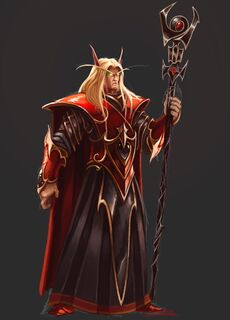
High elves are often prejudiced towards half-elves, though this is starting to change as their presence is becoming more common.[190]
The path by which Prince Kael'thas Sunstrider has chosen to lead the avenging blood elves is one the high elves view with utter disgust and resentment. They strive for a disassociation with the blood elves, such as by hiding their magical addictions and avoiding wearing black and red.[191]
It would not quite be correct to say that the high elves rejoined the Alliance. To many high elves, they never left. Nevertheless, they are often aloof and distant from their allies. They keep to themselves and enjoy wandering forests alone or in small groups. They also maintain the Quel'Danil Lodge, an outpost in the Hinterlands that pursues their diplomatic interests and Quel'Lithien in the Eastern Plaguelands near the gateway to the ruined Quel'Thalas.
The years of conflict between the night elves and the high elves number so many that they make the Alliance and Horde conflict look like children arguing over a toy. When the high elves lost their immortality, they eventually forgot their brethren as generations lived and died, creating legends of histories. The night elves remembered the damage the highborne brought to the world, and view their descendants as time bombs. When the high elves encountered the night elves, they realized the legends were true and began to resent the fact that the night elves had access to so much power that they refused to use — not to mention the whole matter of exile. Many plot to retake the magically imbued forests for themselves, regardless of the fact that both races belong to the Alliance.[192] Auberdine was one of the few night elf settlements that would tolerate a high elf's presence.[193]
230 years before the First War, the dwarven race split into three factions. The Wildhammers desired to open up trade with the high elves, considered taboo at the time and would serve as one of the catalysts for their war.[194] When it ended, the clan became close allies to the high elves. The two races were united through a mutual appreciation for nature and other cultural similarities.[195] With the Quel'Danil Lodge nearby the dwarven keep of Wildhammer in the Hinterlands, it can be assumed that the high elves have maintained their alliance with the gryphon riding dwarves since the Second War. Wildhammer share the high elves respect for the wilds and nature, and carry a long history of good relations and trust.[196][195][197]
The high elves of Theramore are perhaps the most isolated. Having left mostly before the destruction of Dalaran and Quel'Thalas, they have formed a significant community in the city. They spend a great deal of time hunting the few undead forces in Kalimdor. Theramore's high elves also have another interest in the continent. They have discussed privately the creation of their own realm on Kalimdor. The northern forests, full of moonwells and lush greenery are most attractive, but their control by the night elves is overly frustrating. High elven expeditions, claiming to be tracking undead, often search for suitable sites.[198] Their exposure to the night elves has caused them to develop a great interest in Moonwells, which they seek to find an alternative solution to their addiction. Even the presence of a hidden Moonwell 50 feet away is enough to replenish their mystical energies and makes meditation unnecessary.[179]
Notes and trivia
- Demi-human is a term used to describe some humanoid races, including high elves.[199]
- Undead high elves who died before the blood elves split from the high elves seem to generally go to the Horde, as seen with Sylvanas Windrunner, the dark rangers, and Koltira Deathweaver.
- There are a few NPCs in the game that still use the original high elf models from before the Burning Crusade expansion, the Quel'dorei Ghosts, Quel'dorei Magewraiths, Quel'dorei Wraiths and some of the Shadowsworn Ritualist.
- It was stated in Warcraft II: Tides of Darkness The Official Strategy Guide that some high elves had sided with the kingdom of Alterac in its betrayal of the Alliance of Lordaeron during the Second War.[200] This has not been mentioned since, however.
- High elves were widely speculated to have been a playable race choice for World of Warcraft, though Caydiem mentioned in a Blizzard lore post why this never occurred - the total high elf population being incredibly low.[70] The Horde would receive their biological equivalent, the blood elves, around this time. Although Blizzard has acknowledged player interest in high elves as a "sub race" of sorts, along with Mag'har orcs, Dark Iron dwarves, and other minor races,[201] they were not added in Battle for Azeroth as an Allied race. When asked about this, Ion Hazzikostas stated that high elves are essentially already playable as the blood elves on the Horde and that the void elves are also another flavor of high elves that are playable on the Alliance.[202]
- With World of Warcraft: Shadowlands, the visuals typically ascribed to high elves (being that of their blue eyes) were added as options for the blood elf and void elf races. In the case of the latter, normal-looking skin tones and natural hair color were also added. This was done after an interview with developer Ion Hazzikostas caused himself and the team to revisit the issue.[203] However, high elven skin tones are still not available to players.
- The high elves were originally depicted as much closer to nature, with Warcraft II mentioning elven druids[204] as well as the elves joining the Alliance of Lordaeron partly because the Old Horde intended to defile the very lands of Lordaeron.[205]
- The non-canon roleplaying sourcebooks gave solid population numbers for most races, and put the total high elf population at around 24,810. This was contested, however, given the disproportionate amount of blood elves this would create (more than the entire Alliance and Horde combined), and further complicated by an errata which, among other tweaks, greatly reduced the total high elf number.
- Ultimately, the RPG books became non-canonical, leaving only the Warcraft Encyclopedia's official percentages, the Excerpts from the Journal of Archmage Vargoth, and Blizzard's own statements as an indication of canonical high elf numbers.[206]
- High elves only had a minor appearance in the original World of Warcraft. A small faction - Silvermoon Remnant, was planned to be implemented but never made it into the Live Servers. It is most likely this faction that inspired the Silver Covenant.
- In early builds of Warcraft III: Reign of Chaos the high elves were much more involved in the military of the Alliance of Lordaeron, deploying rangers as hero units, as well as dragonhawk riders and mage-priests.
Gallery
- World of Warcraft
Original pre-The Burning Crusade female model.
A blood elf next to a high elf (pre-Shadowlands).
Alexstrasza in her high elf form (new model).
Nozdormu in his high elf form (new model).
Scholomance Occultist, a high elf member of the Cult of the Damned.
Female high elves had purple eyes in patch 9.0.1 as a bug (reverted in patch 9.0.2).
High elven tent
High elven destroyer
High elven ballista
High elven arcane golem
- Art
Alleria Windrunner in the patch 7.3 key art.
Alleria's concept art in The War Within.
Vereesa Windrunner in Night of the Dragon.
Vereesa in Windrunner: Three Sisters.
Art of Alexstrasza in her high elf visage.
Art of Nozdormu in his high elf visage.
Elder high elves in The Sunwell Trilogy.
Undead high elves in The Sunwell Trilogy.
Dar'Khan Drathir in The Sunwell Trilogy.
Valeera Sanguinar as a child in The Comic.
Vereesa and Anduin in Windrunner: Three Sisters.
Dar'Khan, Galell, Liadrin and Lor'themar in Blood of the Highborne.
Alleria Windrunner in Shadows & Light.
Alleria's portrait in the canceled Warcraft Adventures.
Alleria Windrunner in her character trailer.
Vereesa Windrunner wielding Thori'dal.
Sylvanas Windrunner as Ranger General.
Soulciologist Malicia in Battlegrounds.
- Warcraft series
Elven Ranger unit portrait in Warcraft II.
Elven Archer unit portrait in Warcraft II.
Elven Destroyer in Warcraft II.
An elven ranger from the Warcraft II: Tides of Darkness manual.
Alleria Windrunner in the Warcraft II: Beyond the Dark Portal manual.
Ranger in Warcraft III.
Sorceress in Warcraft III.
Priest in Warcraft III.
High elf Archmage
High elf villager
High elf Sorceress icon.
Anasterian Sunstrider unit portrait.
Sylvanas Windrunner unit portrait.
Thalorien Dawnseeker unit portrait.
Ranger General Sylvanas in her Heroes of the Storm trailer.
See also
References
- ^ Holds the title of "High Elf Representative" while at the Sunwell during the Quel'Delar quest chain. (link)
- ^ a b c d e f g h i j k l m n o p q The Warcraft Encyclopedia: High Elves
- ^ a b c d e Day of the Dragon, chapter 2, pg. 13 - 14
- ^ Silver Covenant Horseman
- ^ a b c Legends Volume 2, Warrior: Divided
- ^ Hira Snowdawn's mount named Cloudwing
- ^ a b Tides of Darkness, chapter 14
- ^ The Warcraft Encyclopedia/Darnassian
- ^ a b c d e f World of Warcraft: Ultimate Visual Guide, Updated and Expanded, pg. 81
- ^ a b c d e f Warcraft III: Reign of Chaos Game Manual#Priest
- ^ Sean Copeland on Twitter
- ^ a b Races of World of Warcraft - Blood Elf
- ^ a b c d e The Warcraft Encyclopedia/Blood Elves
- ^ a b c d Blood of the Highborne, chapter 3
- ^ a b c d e f g h The Warcraft Encyclopedia: High Elves and Blood Elves
- ^ a b c d e f g In the Shadow of the Sun
- ^ Iridi and Vereesa's meeting in Night of the Dragon, chapter 11
- ^ Taela Everstride's gossip text
- ^ a b Night of the Dragon, pg. 7
- ^ a b The Warcraft Encyclopedia/Dath'Remar Sunstrider
- ^ World of Warcraft: Chronicle Volume 1, pg. 117
- ^ World of Warcraft: Chronicle Volume 1, pg. 117 - 118
- ^ a b World of Warcraft: Chronicle Volume 1, pg. 118
- ^ A Good War, pg. 50
- ^ a b c d e f g h i j k Blood of the Highborne, chapter 2
- ^
 [Exile of the High Elves]: "Forever after, they would embrace the sun and be known only as the high elves."
[Exile of the High Elves]: "Forever after, they would embrace the sun and be known only as the high elves."
- ^ World of Warcraft: Chronicle Volume 1, pg. 120
- ^ a b c d e
 [The Founding of Quel'Thalas]
[The Founding of Quel'Thalas]
- ^
 [Eerie Smolderthorn Idol]
[Eerie Smolderthorn Idol]
- ^ a b World of Warcraft: Chronicle Volume 1, pg. 121
- ^ a b World of Warcraft: Chronicle Volume 1, pg. 129
- ^ The Troll Compendium: Early Troll Civilization - Defeat of the Amani Empire
- ^ a b c d The Warcraft Encyclopedia: Anasterian Sunstrider
- ^ a b c d Tales of the Hunt: Thas'dorah, Legacy of the Windrunners
- ^ a b c d
 [Arathor and the Troll Wars]
[Arathor and the Troll Wars]
- ^ a b c d e World of Warcraft: Chronicle Volume 1, pg. 130 - 131
- ^ a b Saga of the Valarjar: Strom'kar, the Warbreaker
- ^ a b Tides of Darkness, chapter 7
- ^

 [10-45] Rendezvous with the Courier
[10-45] Rendezvous with the Courier
- ^
 [60] Ending Areiel
[60] Ending Areiel
- ^ Esara Verrinde gossip text - Dalaran & the Magisters
- ^ The Crossing (WC3 BloodElf)
- ^ a b c
 [15-35] What's in the Box?
[15-35] What's in the Box?
- ^ The First Guardian
- ^ World of Warcraft: Chronicle Volume 1, pg. 135 - 136
- ^
 [15-30] Legacy of the High Elves
[15-30] Legacy of the High Elves
- ^ World of Warcraft: Chronicle Volume 2, pg. 105 - 106
- ^ World of Warcraft: Chronicle Volume 2, pg. 156 - 157
- ^ World of Warcraft: Chronicle Volume 2, pg. 160
- ^ World of Warcraft: Chronicle Volume 2, pg. 162 - 163
- ^ World of Warcraft: Chronicle Volume 2, pg. 164 - 165
- ^ a b World of Warcraft: Chronicle Volume 2, pg. 173
- ^ Beyond the Dark Portal, chapter 14
- ^ Beyond the Dark Portal, pg. 60
- ^ Beyond the Dark Portal, chapter 5
- ^ World of Warcraft: Chronicle Volume 3, pg. 37
- ^ Warcraft III: Reign of Chaos manual, pg. 85
- ^ a b Blood of the Highborne, chapter 4
- ^ Ravages of the Plague
- ^ World of Warcraft: Chronicle Volume 3, pg. 55
- ^ Arthas: Rise of the Lich King, chapter 17
- ^ a b World of Warcraft: Chronicle Volume 3, pg. 61
- ^ World of Warcraft: Sylvanas, pg. 184
- ^ World of Warcraft: Chronicle Volume 3, pg. 63
- ^ Arthas: Rise of the Lich King, pg. 234
- ^ The Well of Eternity, pg. 16 - 17
- ^ World of Warcraft: Chronicle Volume 3, pg. 64
- ^ a b c World of Warcraft: Chronicle Volume 3, pg. 88
- ^ World of Warcraft: Chronicle Volume 3, pg. 65
- ^ a b c Blizzard lore posts
- ^
 [47] Lines of Communication
[47] Lines of Communication
- ^ a b
 [48P] Message to the Wildhammer
[48P] Message to the Wildhammer
- ^
 [10-30] The Highvale Documents
[10-30] The Highvale Documents
- ^ Magister Falath#Quotes
- ^
 [60] The Ranger Lord's Behest
[60] The Ranger Lord's Behest
- ^ Beyond the Dark Portal, chapter 20
- ^ Theloria Shadecloak#Quotes
- ^
 [25-30] The Purification of Quel'Delar
[25-30] The Purification of Quel'Delar
- ^ a b Exploring Azeroth: Northrend, pg. 68
- ^ Jaina Proudmoore: Tides of War, chapter 22
- ^
 [10-30] Quel'Danil Lodge
[10-30] Quel'Danil Lodge
- ^
 [10-30] In Defense of Quel'Danil
[10-30] In Defense of Quel'Danil
- ^
 [10-30] The Highvale Documents
[10-30] The Highvale Documents
- ^
 [15-30] Wretched Hive of Scum and Villainy
[15-30] Wretched Hive of Scum and Villainy
- ^
 [15-30] Descendants of the Highborne,
[15-30] Descendants of the Highborne,  [15-30] Legacy of the High Elves and
[15-30] Legacy of the High Elves and  [15-30] Descendants of the High Elves
[15-30] Descendants of the High Elves
- ^ Leaders' meeting at the Amani Pass
- ^ Jaina Proudmoore: Tides of War, chapter 18
- ^
 [15-35] Tracking the Thieves
[15-35] Tracking the Thieves
- ^ War Crimes, chapter 31
- ^
 [15-35] Jaina's Resolution
[15-35] Jaina's Resolution
- ^
 [15-35] Nowhere to Run
[15-35] Nowhere to Run
- ^
 [15-35] Nowhere to Hide
[15-35] Nowhere to Hide
- ^
 [15-35] Cashing Out
[15-35] Cashing Out
- ^
 [10-35] Unfair Trade
[10-35] Unfair Trade
- ^
 [35] The Storm Gathers
[35] The Storm Gathers
- ^

 [10-45] The Unseen Path
[10-45] The Unseen Path
- ^
 [45] Take Me To Your Leader
[45] Take Me To Your Leader
- ^
 [45] Gates of the Nighthold
[45] Gates of the Nighthold
- ^ Exploring Azeroth: Northrend, pg. 68
- ^ Narasi Snowdawn#Quotes
- ^ Arcanist Taelis#Quotes
- ^ Exploring Azeroth: Northrend, pg. 68
- ^ a b Tides of Darkness, chapter 8
- ^ Height#Playable races
- ^ a b Arthas: Rise of the Lich King, chapter 6
- ^ Day of the Dragon, chapter 3, pg. 37
- ^ Tides of Darkness, pg. 229
- ^ File:Vereesa purple eyes.jpg
- ^ Steve Danuser on Twitter: "Having purple-eyed female high elves everywhere was indeed a bug. And in the process of tracking that down, we decided that it would be a nice bonus to throw in the purple eyes for players. So the NPCs' loss is your gain!"
- ^ New Customizations for Shadowlands Build 36401 - Void Elf and Blood Elf Eye Color
- ^ Excerpts from the Journal of Archmage Vargoth
- ^ Night of the Dragon, pg. 105
- ^ Night of the Dragon, pg. 7
- ^ The Well of Eternity, chapter 2, pg. 30
- ^ World of Warcraft: Chronicle Volume 1, pg. 120 - 121
- ^ World of Warcraft: Chronicle Volume 3, pg. 58
- ^ Arthas: Rise of the Lich King pg. 51
- ^ a b Night of the Dragon, chapter 12, pg. 155
- ^ World of Warcraft: Sylvanas, pg. 61
- ^ Before the Storm, chapter 3
- ^ Sylvanas, chapter 4
- ^ Night of the Dragon, pg. 209
- ^ a b Day of the Dragon, chapter 16, pg. 279 - 280
- ^ Arthas: Rise of the Lich King, chapter 6, pg. 86 (paperback)
- ^ Arthas: Rise of the Lich King, chapter 18, pg. 277 (paperback)
- ^ Ros'eleth#Quotes
- ^ Day of the Dragon, chapter 9
- ^ Mount Journal entry for
 [Quel'dorei Steed]
[Quel'dorei Steed]
- ^


 [1-10] A Fistful of Slivers
[1-10] A Fistful of Slivers
- ^
 [Battle Magister's Regalia]
[Battle Magister's Regalia]
- ^
 [Battle Magister's Enchantments]
[Battle Magister's Enchantments]
- ^ Warcraft III: Reign of Chaos Game Manual#Sorceress
- ^ Warcraft III: Reign of Chaos Game Manual#Arcane Sanctum
- ^ Arthas: Rise of the Lich King, chapter 18
- ^ Warcraft II: Tides of Darkness manual, Alliance Ground Units, Elven Archer
- ^ Warcraft II: Tides of Darkness manual, Alliance Ground Units, Elven Ranger
- ^ The Warcraft Encyclopedia/Farstriders
- ^ Day of the Dragon, pg. 167
- ^ Summoner Nolric
- ^ Scholomance Necrolyte
- ^ Scholomance Necromancer
- ^ Tides of Darkness, chapter 11
- ^ Blood of the Highborne, chapter 1
- ^ Tides of Darkness, chapter 15
- ^
 [1-30] Major Malfunction
[1-30] Major Malfunction
- ^
 [35 Daily] De-Constructed
[35 Daily] De-Constructed
- ^
 [35P Daily] Made for War
[35P Daily] Made for War
- ^ Warcraft II: Tides of Darkness manual, Alliance Naval Units, Elven Destroyer
- ^ In the Shadow of the Sun - Aurora Skycaller: "I had wondered why the pangs of the addiction felt so eased lately. I have not needed... help... to cope."
- ^ Sunwell Trilogy - part 3, return of Quel'Thalas
- ^ a b Quest for Pandaria - Part 4
- ^
 [15-30] Vessels of Power
[15-30] Vessels of Power
- ^
 [15-30] Wretched Hive of Scum and Villainy
[15-30] Wretched Hive of Scum and Villainy
- ^ Micky Neilson on Twitter (2016-10-15). Archived from the original on 2017-07-04. “Yeah I'm pretty sure we decided they didn't see the sun as a god.”
- ^ Blood of the Highborne, chapter 1
- ^ Mehlar Dawnblade
- ^ Burning Crusade Behind The Scenes - Blood Elves. YouTube (2008-03-19).
- ^ ''The Well of Eternity, pg. 13
- ^ Before the Storm, chapter 10
- ^ Night of the Dragon, chapter 8
- ^ Day of the Dragon, chapter 7
- ^
 [10-30] Quel'Danil Lodge
[10-30] Quel'Danil Lodge
- ^

 [10-45] Rendezvous with the Courier
[10-45] Rendezvous with the Courier
- ^
 [60] Ending Areiel
[60] Ending Areiel
- ^ Moonbell
- ^ Arcanist Dulial
- ^ Stormrage, pg. 396
- ^ Sunwell Trilogy - part 3, return of Quel'Thalas
- ^
 [25-30] The Purification of Quel'Delar - Blood Elf version
[25-30] The Purification of Quel'Delar - Blood Elf version
- ^
 [25-30] The Sunreaver Plan &
[25-30] The Sunreaver Plan &  [25-30] The Silver Covenant's Scheme
[25-30] The Silver Covenant's Scheme
- ^ Ask CDev Answers - Round 3
- ^ 4:30 Burning Crusade Behind the Scenes DVD
- ^ Thrall: Twilight of the Aspects, pg. 73
- ^
 [25-30] Return To Caladis Brightspear
[25-30] Return To Caladis Brightspear
- ^ Alliance Player's Guide, pg. 129
- ^ Lands of Conflict, pg. 98 - 99, 115
- ^ a b c d World of Warcraft: The Roleplaying Game, pg. 36
- ^ World of Warcraft: The Roleplaying Game, pg. 174
- ^ a b c Warcraft: The Roleplaying Game, pg. 42 - 43
- ^ Alliance & Horde Compendium, pg. 68
- ^ Monster Guide, pg. 64
- ^ Alliance Player's Guide, pg. 12, 123 - 131
- ^ World of Warcraft: The Roleplaying Game, pg. 9
- ^ World of Warcraft: The Roleplaying Game, pg. 13
- ^ Lands of Conflict, pg. 52
- ^ a b c d e f World of Warcraft: The Roleplaying Game, pg. 37
- ^ Warcraft: The Roleplaying Game, pg. 95
- ^ World of Warcraft: The Roleplaying Game, pg. 77
- ^ Alliance Player's Guide, pg. 93 - 94
- ^ Alliance Player's Guide, pg. 132
- ^ Alliance & Horde Compendium, pg. 68
- ^ World of Warcraft: The Roleplaying Game, pg. 12
- ^ Warcraft: The Roleplaying Game, pg. 193
- ^ Lands of Conflict, pg. 67
- ^ a b Lands of Conflict, pg. 99
- ^ Alliance & Horde Compendium, pg. 14
- ^ Alliance Player's Guide, pg. 170
- ^ Warcraft: The Roleplaying Game, pg. 178
- ^
 [The Alliance of Lordaeron]: "... Lothar was able to convince Lordaeron's demi-human races of the impending threat as well. The Alliance succeeded in gaining the support of the stoic dwarves of Ironforge and a small number of high elves of Quel'Thalas."
[The Alliance of Lordaeron]: "... Lothar was able to convince Lordaeron's demi-human races of the impending threat as well. The Alliance succeeded in gaining the support of the stoic dwarves of Ironforge and a small number of high elves of Quel'Thalas."
- ^ Warcraft II: Tides of Darkness The Official Strategy Guide Chapter 3: The Annals of the Great Alliance, Mission Ten: The Prisoners
- ^ Ian Hazzikostas on Sub Races (~7 minute mark)
- ^ Ion Hazzikostas, RE: Mag'har Orcs and High Elves (1:14:44)
- ^ Ion Hazzikostas on Twitter: "Honestly that was the plan at the time, but the game is vast, so specific questions often go unexamined while attention is elsewhere. After that interview, the team spun up a fresh conversation about BElf/VElf customization options, and the recent blog lays out where we ended up."
- ^ Warcraft II: Tides of Darkness manual, Places of Mystery, The Runestone at Caer Darrow
- ^ Warcraft II: Tides of Darkness manual, A Brief History of the Fall of Azeroth, The Alliance of Lordaeron
- ^ Ask CDev Answers - Round 2
| ||||||||||||||
| |||||||||||||||||||||||||||||||||||

